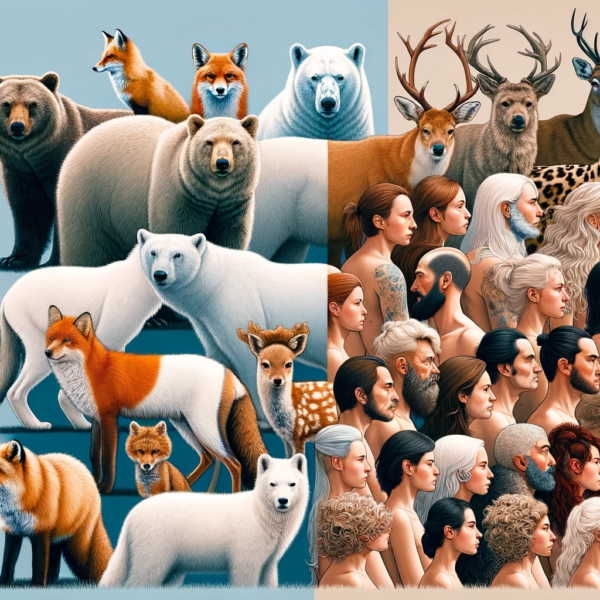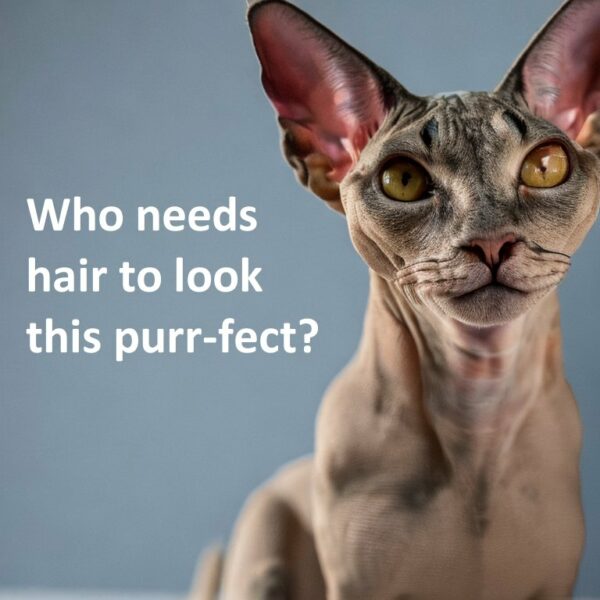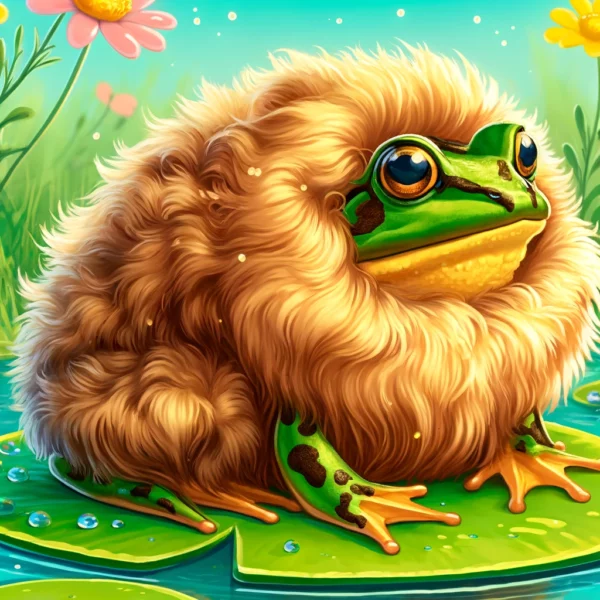The typical human has about 2 million hair follicles with around 1 million on the head (of which about 100,000 are big terminal hair follicles on our scalps) and another million spread over the rest of our bodies. The main function of each hair follicle structure in our skin is to produce a hair shaft or fiber. The shaft is the physically visible portion of the hair and plays a significant role both biologically and psychologically.
Mammals other than humans can produce a wide variety of hair types that can have different functions. For example, mice and rats make at least five different hair fiber types (awl, auchene, zigzag, guard, and vibrissa since you ask). Arguably, another 2 hair types can be added if you consider the eyebrow (mice have just a single eyebrow hair) and ear hair (very short, fine hair on their ears) as distinct types. In contrast, compared to other mammals, humans don’t have very many variations in the kind of hair fibers they produce.
Essentially, humans only make two basic types of hair fiber: The fibers are coarse and pigmented when they form the body hair or scalp and these are known as “terminal” hair. The finer downy hair on the face is known as “vellus” hair. The follicles in different parts of the body can produce hair fibers of different size, shape and color, but biologists only recognise these two basic hair types as present in humans.
Most hair fibers in humans are composed of two main parts – the cuticle and the cortex. Some hair fibers also have a central column of loosely packed cells that form the medulla, but in humans, hairs with a medulla are generally only found as we age and the hair becomes grey, thick, and coarse. The cuticle is a layer of cells, which forms the outermost coating of the hair shaft. The cortex forms the bulk of the hair. The cells in the cortex can contain melanin, which is responsible for hair pigmentation.
Hair fiber as a distinctive feature of mammals plays a multitude of roles that go beyond mere aesthetics. And despite our limited repertoire of hair types, human hair also has a wide range of functions.
1. Camouflage and Protection in Animals
In the animal kingdom, hair serves as a vital element for survival. For instance, the fur of arctic animals like polar bears and arctic foxes blends with the snowy environment, providing essential camouflage against predators. Additionally, the thickness and color of animal fur can change with seasons, further aiding in concealment and protection. Artic foxes shed their wite winter coat in spring and grow a pigmented summer coat so they still have camouflage when the snow melts.
2. Social Communication in Humans
Hair in humans transcends its basic biological functions, becoming a powerful tool for social communication. The way individuals style, color, and maintain their hair can convey a wealth of information about their personality, social status, and cultural affiliations. This aspect of hair as a medium for self-expression is unique to humans and significantly impacts our social interactions.
3. Thermal Regulation
Both in humans and other mammals, hair plays a crucial role in regulating body temperature. It traps a layer of air close to the skin, providing insulation against cold environments. Conversely, in hot conditions, hair can help in dissipating heat, thereby preventing overheating. The color of fur has a significant impact on body temperature with light coloured coats being more effective than darker colours at reflecting light. How glossy the coat is can also alter the amount of light reflected. In horses, their mane helps with the shedding of rainwater and it insulates the head and the major blood vessels to the brain. In zebras, there are temperature differences between their black and white stripes and this might cause chaotic air movement above the hair surface, that enhances evaporative heat dissipation. Interestingly, elephants have a low hair density – as you might expect in a hot climate – but research suggests the low hair density actually helps speed up heat loss compared to having no hair at all. How it works is complicated, but essentially, the elephants’ low hair density means heat is not trapped next to the skin, but also the few remaining hairs act as tiny “pin fins” that increase heat exchange from the skin to the air. In some animals, fur density and texture can change according to seasonal climate changes, playing a key role in maintaining optimal body temperature throughout the year.
4. Physical Barrier against Trauma and Radiation
Hair fibers form a protective layer over the skin, shielding it from various physical traumas such as minor cuts, abrasions, and insect bites. This is particularly useful for mammals with very dense fur that live in forests or savanna where the undergrowth can be thick and plants can have thorns. Some biologists have suggested that the ruff of thick long hair on male lions might protect their necks during fighting – though other biologists dispute this. For humans, this protective function is more limited compared to other mammals as we have lost much of our body hair. For humans, hair, particularly on the scalp, offers protection against harmful ultraviolet radiation from the sun, reducing the risk of skin damage and associated diseases including cancer.
5. Enhancing Evaporation and Pheromone Release
Another significant function of hair, especially in humans, is increasing the surface area for sweat evaporation. This process is crucial for thermoregulation. Dense hair is not useful for sweat evaporation (as on our scalps), but a low hair density, as with human body hair, can help increase sweat evaporation. Additionally, hair follicles in the arm pits in humans have apocrine glands attached to them, which secrete pheromones. These chemical signals play a role in social and reproductive communications among humans. One of the functions of armpit hair is probably to increase the evaporation of the pheromone scent. Other mammals can also have apocrine glands to secrete pheromones and may also have other specialised glands for secretions.
6. Specialized Protection by Facial Hair
Facial hair, including nose hair, eyebrows, and eyelashes, serves specialized protective functions. Nose hair acts as a physical barrier against dust and insects, preventing them from entering the respiratory system. Eyebrows protect the eyes from sun glare, while eyelashes guard against dust and small particles, keeping the eyes clean and moist. Similar to lions (see above) some anthropologists speculate that beard hair in men might be useful for protecting the neck.
7. Psycho-Emotional Impact in Humans
Hair can have a profound psycho-emotional impact on humans. Conditions like alopecia (hair loss) or hirsutism (excessive hair growth) can lead to significant psychosocial stress and trauma. This aspect underscores the importance of hair biology studies and the development of therapeutic interventions to manage hair growth disorders. It may even have some effect in other mammals. Limited research suggests that when other animals lose their fur, it can influence their psychological state as well.
8. Ornamental Function Across the Body
Hair’s ornamental function is particularly prominent in humans. The hair on different parts of the body, such as the scalp, face, and even pubic region, plays a role in the overall aesthetic appeal and is often groomed to align with cultural beauty standards. Though it should be noted that these ideals can differ greatly in various parts of the world. This function is less pronounced in other mammals, where fur patterns and colors are more related to species-specific needs, but fur grooming can still play a role in mate attraction for other animals.
9. Sensory Functions
Hair fibers are sensitive to external stimuli. Movements of the hair are detected by the follicle and transmitted as sensory signals to the nervous system. This function is akin to that of “antennas”, making hair an integral part of the sensory system in both humans and animals. Humans can sense hair movement pretty well, but rodents take it to the next level with their whiskers (called vibrissae) that are incredibly sensitive.
10. Potential Role in Toxin Elimination
Recent commentary has introduced a fascinating speculation regarding the role of hair fiber; the potential for toxin elimination from the body. This emerging hypothesis suggests that hair fibers might aid in the removal of heavy metals and other toxins. As hair grows very fast (hair keratinocyte cells are some of the fastest dividing cells in the body), it could potentially absorb and encapsulate these harmful substances, effectively removing them from the body’s system. We know that hair can contain high concentrations of toxins such as mercury, and testing the hair has long been regarded as an effective way to measure heavy metal exposure. While the extent and efficiency of this toxin “excretion” process requires further scientific study, the concept adds another layer to the functional complexity of hair.
Conclusion
The functions of hair fiber in humans and other mammals are diverse and multifaceted. While in animals, hair primarily serves as camouflage, protection, and thermal regulation, in humans, it takes on additional roles in social communication, psycho-emotional well-being, and aesthetics.
That hair fiber might also have an excretory function to help in removal of toxins, underscores hairs’ potential role not just in protection and social dynamics, but also in maintaining physiological health. This intriguing possibility opens new avenues for research in understanding the full spectrum of hair fibers’ biological functions.
This complexity of hair fiber reflects the evolutionary significance of hair and underscores the importance of ongoing research in hair biology, both for understanding its functions and for developing effective treatments for hair-related disorders. The intricate interplay between the biological and social functions of hair highlights its integral role in the lives of humans and animals alike.
Bibliography
11711645 {11711645:GGVQUPJX},{11711645:R8BJJFUJ},{11711645:DEQTJD92},{11711645:5JJ5UCXV},{11711645:UKF5JQCT},{11711645:54AC6BXJ},{11711645:TXD36UZW},{11711645:Q9VZGH4F},{11711645:TCKA48DW},{11711645:HHJNQKJ7},{11711645:UC3WZF3Q},{11711645:PT55FEB5},{11711645:Z9WQ33G7},{11711645:UGVRD2VK},{11711645:Z88A6U5R},{11711645:6UZ5B4ZC},{11711645:GG4477D6},{11711645:RGA9UXGQ},{11711645:2NQXFEU4} vancouver 50 date asc 604 https://www.keratin.com/wp-content/plugins/zotpress/ %7B%22status%22%3A%22success%22%2C%22updateneeded%22%3Afalse%2C%22instance%22%3A%22zotpress-c741fd2f224419d34e28f91ab5806514%22%2C%22meta%22%3A%7B%22request_last%22%3A0%2C%22request_next%22%3A0%2C%22used_cache%22%3Atrue%7D%2C%22data%22%3A%5B%7B%22key%22%3A%22GG4477D6%22%2C%22library%22%3A%7B%22id%22%3A11711645%7D%2C%22meta%22%3A%7B%22creatorSummary%22%3A%22Tregear%22%2C%22parsedDate%22%3A%221965-07%22%2C%22numChildren%22%3A0%7D%2C%22bib%22%3A%22%3Cdiv%20class%3D%5C%22csl-bib-body%5C%22%20style%3D%5C%22line-height%3A%201.35%3B%20%5C%22%3E%5Cn%20%20%3Cdiv%20class%3D%5C%22csl-entry%5C%22%20style%3D%5C%22clear%3A%20left%3B%20%5C%22%3E%5Cn%20%20%20%20%3Cdiv%20class%3D%5C%22csl-left-margin%5C%22%20style%3D%5C%22float%3A%20left%3B%20padding-right%3A%200.5em%3B%20text-align%3A%20right%3B%20width%3A%201em%3B%5C%22%3E1.%3C%5C%2Fdiv%3E%3Cdiv%20class%3D%5C%22csl-right-inline%5C%22%20style%3D%5C%22margin%3A%200%20.4em%200%201.5em%3B%5C%22%3ETregear%20RT.%20Hair%20density%2C%20wind%20speed%2C%20and%20heat%20loss%20in%20mammals.%20J%20Appl%20Physiol.%201965%20Jul%3B20%284%29%3A796%26%23x2013%3B801.%3C%5C%2Fdiv%3E%5Cn%20%20%20%3C%5C%2Fdiv%3E%5Cn%3C%5C%2Fdiv%3E%22%2C%22data%22%3A%7B%22itemType%22%3A%22journalArticle%22%2C%22title%22%3A%22Hair%20density%2C%20wind%20speed%2C%20and%20heat%20loss%20in%20mammals%22%2C%22creators%22%3A%5B%7B%22creatorType%22%3A%22author%22%2C%22firstName%22%3A%22R.%20T.%22%2C%22lastName%22%3A%22Tregear%22%7D%5D%2C%22abstractNote%22%3A%22%22%2C%22date%22%3A%221965-07%22%2C%22language%22%3A%22eng%22%2C%22DOI%22%3A%2210.1152%5C%2Fjappl.1965.20.4.796%22%2C%22ISSN%22%3A%220021-8987%22%2C%22url%22%3A%22%22%2C%22collections%22%3A%5B%224GSZ6P2B%22%5D%2C%22dateModified%22%3A%222023-11-11T15%3A38%3A49Z%22%7D%7D%2C%7B%22key%22%3A%22RGA9UXGQ%22%2C%22library%22%3A%7B%22id%22%3A11711645%7D%2C%22meta%22%3A%7B%22creatorSummary%22%3A%22West%20and%20Packer%22%2C%22parsedDate%22%3A%222002-08-23%22%2C%22numChildren%22%3A0%7D%2C%22bib%22%3A%22%3Cdiv%20class%3D%5C%22csl-bib-body%5C%22%20style%3D%5C%22line-height%3A%201.35%3B%20%5C%22%3E%5Cn%20%20%3Cdiv%20class%3D%5C%22csl-entry%5C%22%20style%3D%5C%22clear%3A%20left%3B%20%5C%22%3E%5Cn%20%20%20%20%3Cdiv%20class%3D%5C%22csl-left-margin%5C%22%20style%3D%5C%22float%3A%20left%3B%20padding-right%3A%200.5em%3B%20text-align%3A%20right%3B%20width%3A%201em%3B%5C%22%3E1.%3C%5C%2Fdiv%3E%3Cdiv%20class%3D%5C%22csl-right-inline%5C%22%20style%3D%5C%22margin%3A%200%20.4em%200%201.5em%3B%5C%22%3EWest%20PM%2C%20Packer%20C.%20Sexual%20selection%2C%20temperature%2C%20and%20the%20lion%26%23x2019%3Bs%20mane.%20Science.%202002%20Aug%2023%3B297%285585%29%3A1339%26%23x2013%3B43.%3C%5C%2Fdiv%3E%5Cn%20%20%20%3C%5C%2Fdiv%3E%5Cn%3C%5C%2Fdiv%3E%22%2C%22data%22%3A%7B%22itemType%22%3A%22journalArticle%22%2C%22title%22%3A%22Sexual%20selection%2C%20temperature%2C%20and%20the%20lion%27s%20mane%22%2C%22creators%22%3A%5B%7B%22creatorType%22%3A%22author%22%2C%22firstName%22%3A%22Peyton%20M.%22%2C%22lastName%22%3A%22West%22%7D%2C%7B%22creatorType%22%3A%22author%22%2C%22firstName%22%3A%22Craig%22%2C%22lastName%22%3A%22Packer%22%7D%5D%2C%22abstractNote%22%3A%22The%20mane%20of%20the%20African%20lion%20%28Panthera%20leo%29%20is%20a%20highly%20variable%20trait%20that%20reflects%20male%20condition%20and%20ambient%20temperature.%20We%20examined%20the%20consequences%20of%20this%20variation%20in%20a%20long-term%20study%20of%20lions%20in%20the%20Serengeti%20National%20Park%2C%20Tanzania.%20Mane%20darkness%20indicates%20nutrition%20and%20testosterone%20and%20influences%20both%20female%20choice%20and%20male-male%20competition.%20Mane%20length%20signals%20fighting%20success%20and%20only%20appears%20to%20influence%20male-male%20assessment.%20Dark-maned%20males%20enjoy%20longer%20reproductive%20life-spans%20and%20higher%20offspring%20survival%2C%20but%20they%20suffer%20higher%20surface%20temperatures%2C%20abnormal%20sperm%2C%20and%20lower%20food%20intake%20during%20hot%20months%20of%20the%20year.%20Maned%20males%20are%20hotter%20than%20females%2C%20and%20males%20have%20lighter%20and%5C%2For%20shorter%20manes%20in%20hotter%20seasons%2C%20years%2C%20and%20habitats.%20This%20phenotypic%20plasticity%20suggests%20that%20the%20mane%20will%20respond%20to%20forecasted%20increases%20in%20ambient%20temperature.%22%2C%22date%22%3A%222002-08-23%22%2C%22language%22%3A%22eng%22%2C%22DOI%22%3A%2210.1126%5C%2Fscience.1073257%22%2C%22ISSN%22%3A%221095-9203%22%2C%22url%22%3A%22%22%2C%22collections%22%3A%5B%224GSZ6P2B%22%5D%2C%22dateModified%22%3A%222023-11-11T16%3A00%3A20Z%22%7D%7D%2C%7B%22key%22%3A%2254AC6BXJ%22%2C%22library%22%3A%7B%22id%22%3A11711645%7D%2C%22meta%22%3A%7B%22creatorSummary%22%3A%22Dunnett%20and%20Lees%22%2C%22parsedDate%22%3A%222003-10%22%2C%22numChildren%22%3A0%7D%2C%22bib%22%3A%22%3Cdiv%20class%3D%5C%22csl-bib-body%5C%22%20style%3D%5C%22line-height%3A%201.35%3B%20%5C%22%3E%5Cn%20%20%3Cdiv%20class%3D%5C%22csl-entry%5C%22%20style%3D%5C%22clear%3A%20left%3B%20%5C%22%3E%5Cn%20%20%20%20%3Cdiv%20class%3D%5C%22csl-left-margin%5C%22%20style%3D%5C%22float%3A%20left%3B%20padding-right%3A%200.5em%3B%20text-align%3A%20right%3B%20width%3A%201em%3B%5C%22%3E1.%3C%5C%2Fdiv%3E%3Cdiv%20class%3D%5C%22csl-right-inline%5C%22%20style%3D%5C%22margin%3A%200%20.4em%200%201.5em%3B%5C%22%3EDunnett%20M%2C%20Lees%20P.%20Trace%20element%2C%20toxin%20and%20drug%20elimination%20in%20hair%20with%20particular%20reference%20to%20the%20horse.%20Res%20Vet%20Sci.%202003%20Oct%3B75%282%29%3A89%26%23x2013%3B101.%3C%5C%2Fdiv%3E%5Cn%20%20%20%3C%5C%2Fdiv%3E%5Cn%3C%5C%2Fdiv%3E%22%2C%22data%22%3A%7B%22itemType%22%3A%22journalArticle%22%2C%22title%22%3A%22Trace%20element%2C%20toxin%20and%20drug%20elimination%20in%20hair%20with%20particular%20reference%20to%20the%20horse%22%2C%22creators%22%3A%5B%7B%22creatorType%22%3A%22author%22%2C%22firstName%22%3A%22M.%22%2C%22lastName%22%3A%22Dunnett%22%7D%2C%7B%22creatorType%22%3A%22author%22%2C%22firstName%22%3A%22P.%22%2C%22lastName%22%3A%22Lees%22%7D%5D%2C%22abstractNote%22%3A%22%22%2C%22date%22%3A%222003-10%22%2C%22language%22%3A%22eng%22%2C%22DOI%22%3A%2210.1016%5C%2Fs0034-5288%2803%2900074-2%22%2C%22ISSN%22%3A%220034-5288%22%2C%22url%22%3A%22%22%2C%22collections%22%3A%5B%224GSZ6P2B%22%5D%2C%22dateModified%22%3A%222023-11-11T15%3A34%3A42Z%22%7D%7D%2C%7B%22key%22%3A%22TCKA48DW%22%2C%22library%22%3A%7B%22id%22%3A11711645%7D%2C%22meta%22%3A%7B%22creatorSummary%22%3A%22Hunt%20and%20McHale%22%2C%22parsedDate%22%3A%222004-12-16%22%2C%22numChildren%22%3A0%7D%2C%22bib%22%3A%22%3Cdiv%20class%3D%5C%22csl-bib-body%5C%22%20style%3D%5C%22line-height%3A%201.35%3B%20%5C%22%3E%5Cn%20%20%3Cdiv%20class%3D%5C%22csl-entry%5C%22%20style%3D%5C%22clear%3A%20left%3B%20%5C%22%3E%5Cn%20%20%20%20%3Cdiv%20class%3D%5C%22csl-left-margin%5C%22%20style%3D%5C%22float%3A%20left%3B%20padding-right%3A%200.5em%3B%20text-align%3A%20right%3B%20width%3A%201em%3B%5C%22%3E1.%3C%5C%2Fdiv%3E%3Cdiv%20class%3D%5C%22csl-right-inline%5C%22%20style%3D%5C%22margin%3A%200%20.4em%200%201.5em%3B%5C%22%3EHunt%20N%2C%20McHale%20S.%20Reported%20experiences%20of%20persons%20with%20alopecia%20areata.%20Journal%20of%20Loss%20and%20Trauma.%202004%20Dec%2016%3B10%281%29%3A33%26%23x2013%3B50.%3C%5C%2Fdiv%3E%5Cn%20%20%20%3C%5C%2Fdiv%3E%5Cn%3C%5C%2Fdiv%3E%22%2C%22data%22%3A%7B%22itemType%22%3A%22journalArticle%22%2C%22title%22%3A%22Reported%20experiences%20of%20persons%20with%20alopecia%20areata%22%2C%22creators%22%3A%5B%7B%22creatorType%22%3A%22author%22%2C%22firstName%22%3A%22Nigel%22%2C%22lastName%22%3A%22Hunt%22%7D%2C%7B%22creatorType%22%3A%22author%22%2C%22firstName%22%3A%22Sue%22%2C%22lastName%22%3A%22McHale%22%7D%5D%2C%22abstractNote%22%3A%22%22%2C%22date%22%3A%222004-12-16%22%2C%22language%22%3A%22en%22%2C%22DOI%22%3A%2210.1080%5C%2F15325020490890633%22%2C%22ISSN%22%3A%221532-5024%2C%201532-5032%22%2C%22url%22%3A%22%22%2C%22collections%22%3A%5B%22IPMDJI7J%22%5D%2C%22dateModified%22%3A%222023-08-05T15%3A09%3A55Z%22%7D%7D%2C%7B%22key%22%3A%222NQXFEU4%22%2C%22library%22%3A%7B%22id%22%3A11711645%7D%2C%22meta%22%3A%7B%22creatorSummary%22%3A%22Yu%20et%20al.%22%2C%22parsedDate%22%3A%222006%22%2C%22numChildren%22%3A0%7D%2C%22bib%22%3A%22%3Cdiv%20class%3D%5C%22csl-bib-body%5C%22%20style%3D%5C%22line-height%3A%201.35%3B%20%5C%22%3E%5Cn%20%20%3Cdiv%20class%3D%5C%22csl-entry%5C%22%20style%3D%5C%22clear%3A%20left%3B%20%5C%22%3E%5Cn%20%20%20%20%3Cdiv%20class%3D%5C%22csl-left-margin%5C%22%20style%3D%5C%22float%3A%20left%3B%20padding-right%3A%200.5em%3B%20text-align%3A%20right%3B%20width%3A%201em%3B%5C%22%3E1.%3C%5C%2Fdiv%3E%3Cdiv%20class%3D%5C%22csl-right-inline%5C%22%20style%3D%5C%22margin%3A%200%20.4em%200%201.5em%3B%5C%22%3EYu%20M%2C%20Finner%20A%2C%20Shapiro%20J%2C%20Lo%20B%2C%20Barekatain%20A%2C%20McElwee%20KJ.%20Hair%20follicles%20and%20their%20role%20in%20skin%20health.%20Expert%20Review%20of%20Dermatology.%202006%3B1%286%29%3A855%26%23x2013%3B71.%3C%5C%2Fdiv%3E%5Cn%20%20%20%3C%5C%2Fdiv%3E%5Cn%3C%5C%2Fdiv%3E%22%2C%22data%22%3A%7B%22itemType%22%3A%22journalArticle%22%2C%22title%22%3A%22Hair%20follicles%20and%20their%20role%20in%20skin%20health%22%2C%22creators%22%3A%5B%7B%22creatorType%22%3A%22author%22%2C%22firstName%22%3A%22Mei%22%2C%22lastName%22%3A%22Yu%22%7D%2C%7B%22creatorType%22%3A%22author%22%2C%22firstName%22%3A%22Andreas%22%2C%22lastName%22%3A%22Finner%22%7D%2C%7B%22creatorType%22%3A%22author%22%2C%22firstName%22%3A%22Jerry%22%2C%22lastName%22%3A%22Shapiro%22%7D%2C%7B%22creatorType%22%3A%22author%22%2C%22firstName%22%3A%22Blanche%22%2C%22lastName%22%3A%22Lo%22%7D%2C%7B%22creatorType%22%3A%22author%22%2C%22firstName%22%3A%22Armin%22%2C%22lastName%22%3A%22Barekatain%22%7D%2C%7B%22creatorType%22%3A%22author%22%2C%22firstName%22%3A%22Kevin%20J%22%2C%22lastName%22%3A%22McElwee%22%7D%5D%2C%22abstractNote%22%3A%22Hair%20follicles%20produce%20hair%20fibers%20in%20a%20regular%20cycle.%20As%20part%20of%20their%20hair-producing%20role%2C%20hair%20follicles%20retain%20stem%20cells%2C%20promote%20cell%20growth%20and%20tissue%20invasion%20and%20induce%20angiogenesis.%20However%2C%20hair%20follicle%20function%20involves%20more%20than%20just%20hair%20fiber%20production.%20Hair%20follicles%20interact%20closely%20with%20the%20skin%20immune%20and%20neuroendocrine%20systems%2C%20supporting%20immunosurveilance%20against%20pathogens%20and%20aiding%20sensory%20perception.%20Hair%20follicles%20can%20also%20assist%20in%20wound%20healing%20and%20skin%20repigmentation.%20However%2C%20the%20unique%20properties%20of%20hair%20follicles%20can%20also%20be%20detrimental%20to%20skin%20health.%20Perhaps%20most%20significantly%2C%20hair%20follicles%20may%20contribute%20to%20the%20development%20of%20skin%20neoplasias.%20This%20article%20reviews%20the%20potential%20role%20of%20hair%20follicles%20in%20skin%20health.%22%2C%22date%22%3A%2212%5C%2F2006%22%2C%22language%22%3A%22en%22%2C%22DOI%22%3A%2210.1586%5C%2F17469872.1.6.855%22%2C%22ISSN%22%3A%221746-9872%2C%201746-9880%22%2C%22url%22%3A%22%22%2C%22collections%22%3A%5B%224GSZ6P2B%22%5D%2C%22dateModified%22%3A%222023-11-11T16%3A31%3A55Z%22%7D%7D%2C%7B%22key%22%3A%22Q9VZGH4F%22%2C%22library%22%3A%7B%22id%22%3A11711645%7D%2C%22meta%22%3A%7B%22creatorSummary%22%3A%22Green%20et%20al.%22%2C%22parsedDate%22%3A%222006-12%22%2C%22numChildren%22%3A0%7D%2C%22bib%22%3A%22%3Cdiv%20class%3D%5C%22csl-bib-body%5C%22%20style%3D%5C%22line-height%3A%201.35%3B%20%5C%22%3E%5Cn%20%20%3Cdiv%20class%3D%5C%22csl-entry%5C%22%20style%3D%5C%22clear%3A%20left%3B%20%5C%22%3E%5Cn%20%20%20%20%3Cdiv%20class%3D%5C%22csl-left-margin%5C%22%20style%3D%5C%22float%3A%20left%3B%20padding-right%3A%200.5em%3B%20text-align%3A%20right%3B%20width%3A%201em%3B%5C%22%3E1.%3C%5C%2Fdiv%3E%3Cdiv%20class%3D%5C%22csl-right-inline%5C%22%20style%3D%5C%22margin%3A%200%20.4em%200%201.5em%3B%5C%22%3EGreen%20AC%2C%20Kimlin%20M%2C%20Siskind%20V%2C%20Whiteman%20DC.%20Hypothesis%3A%20hair%20cover%20can%20protect%20against%20invasive%20melanoma%20on%20the%20head%20and%20neck%20%28Australia%29.%20Cancer%20Causes%20Control.%202006%20Dec%3B17%2810%29%3A1263%26%23x2013%3B6.%3C%5C%2Fdiv%3E%5Cn%20%20%20%3C%5C%2Fdiv%3E%5Cn%3C%5C%2Fdiv%3E%22%2C%22data%22%3A%7B%22itemType%22%3A%22journalArticle%22%2C%22title%22%3A%22Hypothesis%3A%20hair%20cover%20can%20protect%20against%20invasive%20melanoma%20on%20the%20head%20and%20neck%20%28Australia%29%22%2C%22creators%22%3A%5B%7B%22creatorType%22%3A%22author%22%2C%22firstName%22%3A%22Ad%5Cu00e8le%20C.%22%2C%22lastName%22%3A%22Green%22%7D%2C%7B%22creatorType%22%3A%22author%22%2C%22firstName%22%3A%22Michael%22%2C%22lastName%22%3A%22Kimlin%22%7D%2C%7B%22creatorType%22%3A%22author%22%2C%22firstName%22%3A%22Victor%22%2C%22lastName%22%3A%22Siskind%22%7D%2C%7B%22creatorType%22%3A%22author%22%2C%22firstName%22%3A%22David%20C.%22%2C%22lastName%22%3A%22Whiteman%22%7D%5D%2C%22abstractNote%22%3A%22The%20anatomic%20distribution%20of%20cutaneous%20melanoma%20reflects%20people%27s%20levels%20and%20patterns%20of%20sun%20exposure.%20While%20examining%20trends%20of%20incident%20invasive%20melanomas%20by%20site%20in%20recent%20decades%20in%20Australia%20we%20noted%20significant%20increases%20in%20incidence%20on%20the%20ears%20but%20not%20the%20face%20or%20any%20other%20site%20in%20women%20younger%20than%2040%20years%2C%20by%206%25%20%2895%25%20confidence%20interval%20%5BCI%5D%202-10%25%29%20per%20year%2C%20and%2040-59%20years%20by%207%25%20%2895%25%20CI%204-10%25%29%20per%20year.%20Men%20of%20the%20same%20age%20showed%20no%20corresponding%20changes%20in%20ear%20melanoma.%20However%20incidence%20rates%20of%20ear%20melanoma%20in%20general%20were%20fourfold%20higher%20in%20males%20than%20females%20in%20Australia.%20Further%2C%20using%20data%20from%20the%20National%20Cancer%20Institute%27s%20Surveillance%2C%20Epidemiology%20and%20End%20Results%20%28SEER%29%20Program%2C%20rates%20of%20invasive%20melanoma%20on%20the%20ear%20were%20found%20to%20be%20sevenfold%20higher%20in%20males%20than%20females%20in%20the%20US%20population%20in%20the%20same%20period.%20Higher%20rates%20of%20scalp%20and%20neck%20melanomas%20were%20also%20seen%20in%20men%20and%20women%20in%20both%20populations.%20We%20therefore%20speculated%20that%20the%20isolated%20rises%20of%20ear%20melanoma%20in%20younger%20women%20in%20Australia%2C%20and%20the%20higher%20overall%20rates%20of%20ear%2C%20scalp%20and%20neck%20melanoma%20in%20men%20compared%20with%20women%2C%20reflect%20differences%20in%20hair%20coverage.%20We%20tested%20the%20specific%20hypothesis%20that%20hair%20cover%20reduces%20sun%20exposure%20of%20the%20ears%20using%20experimental%20manikins%20and%20found%20that%20hair%20cover%20of%20the%20ear%20reduced%20solar%20ultraviolet-B%20exposure%20by%2081%25%20%5BSE%20%2B%5C%2F-8%5D%20compared%20with%20uncovered%20ears.%20We%20conclude%20that%20hair%20cover%20can%20protect%20against%20invasive%20melanoma%20on%20the%20ear%20and%20may%20similarly%20protect%20on%20the%20scalp%20and%20neck.%20When%20discretionary%2C%20hair%20may%20be%20an%20important%20additional%20factor%20to%20be%20considered%20for%20melanoma%20prevention.%22%2C%22date%22%3A%222006-12%22%2C%22language%22%3A%22eng%22%2C%22DOI%22%3A%2210.1007%5C%2Fs10552-006-0063-1%22%2C%22ISSN%22%3A%220957-5243%22%2C%22url%22%3A%22%22%2C%22collections%22%3A%5B%224GSZ6P2B%22%5D%2C%22dateModified%22%3A%222023-11-11T15%3A59%3A48Z%22%7D%7D%2C%7B%22key%22%3A%22PT55FEB5%22%2C%22library%22%3A%7B%22id%22%3A11711645%7D%2C%22meta%22%3A%7B%22creatorSummary%22%3A%22Randall%20and%20Botchkareva%22%2C%22parsedDate%22%3A%222009-01-01%22%2C%22numChildren%22%3A0%7D%2C%22bib%22%3A%22%3Cdiv%20class%3D%5C%22csl-bib-body%5C%22%20style%3D%5C%22line-height%3A%201.35%3B%20%5C%22%3E%5Cn%20%20%3Cdiv%20class%3D%5C%22csl-entry%5C%22%20style%3D%5C%22clear%3A%20left%3B%20%5C%22%3E%5Cn%20%20%20%20%3Cdiv%20class%3D%5C%22csl-left-margin%5C%22%20style%3D%5C%22float%3A%20left%3B%20padding-right%3A%200.5em%3B%20text-align%3A%20right%3B%20width%3A%201em%3B%5C%22%3E1.%3C%5C%2Fdiv%3E%3Cdiv%20class%3D%5C%22csl-right-inline%5C%22%20style%3D%5C%22margin%3A%200%20.4em%200%201.5em%3B%5C%22%3ERandall%20VA%2C%20Botchkareva%20NV.%20Chapter%201%20-%20The%20Biology%20of%20Hair%20Growth.%20In%3A%20Ahluwalia%20GS%2C%20editor.%20Cosmetics%20Applications%20of%20Laser%20%26amp%3B%20Light-Based%20Systems.%20Boston%3A%20William%20Andrew%20Publishing%3B%202009.%20p.%203%26%23x2013%3B35.%20%28Personal%20Care%20%26amp%3B%20Cosmetic%20Technology%29.%3C%5C%2Fdiv%3E%5Cn%20%20%20%3C%5C%2Fdiv%3E%5Cn%3C%5C%2Fdiv%3E%22%2C%22data%22%3A%7B%22itemType%22%3A%22bookSection%22%2C%22title%22%3A%22Chapter%201%20-%20The%20Biology%20of%20Hair%20Growth%22%2C%22creators%22%3A%5B%7B%22creatorType%22%3A%22author%22%2C%22firstName%22%3A%22Valerie%20Anne%22%2C%22lastName%22%3A%22Randall%22%7D%2C%7B%22creatorType%22%3A%22author%22%2C%22firstName%22%3A%22Natalia%20V.%22%2C%22lastName%22%3A%22Botchkareva%22%7D%2C%7B%22creatorType%22%3A%22editor%22%2C%22firstName%22%3A%22Gurpreet%20S.%22%2C%22lastName%22%3A%22Ahluwalia%22%7D%5D%2C%22abstractNote%22%3A%22This%20chapter%20reviews%20the%20functions%20of%20hair%2C%20its%20structure%20and%20the%20processes%20occurring%20during%20the%20hair%20growth%20cycle%2C%20the%20changes%20which%20can%20occur%20with%20the%20seasons%2C%20and%20the%20importance%20of%20the%20main%20regulator%20of%20human%20hair%20growth%2C%20the%20androgens.%20Its%20main%20focus%20lies%20on%20human%20hair%20growth.%20Mammalian%20skin%20produces%20hair%20everywhere%20except%20for%20the%20glabrous%20skin%20of%20the%20lips%2C%20palms%2C%20and%20soles.%20Although%20obvious%20in%20most%20mammals%2C%20human%20hair%20growth%20is%20so%20reduced%20with%20tiny%2C%20virtually%20colorless%20vellus%20hairs%20in%20many%20areas%2C%20that%20we%20are%20termed%20the%20%5Cu201cnaked%20ape.%5Cu201d%20Externally%20hairs%20are%20thin%2C%20flexible%20tubes%20of%20dead%2C%20fully%20keratinised%20epithelial%20cells%3B%20they%20vary%20in%20color%2C%20length%2C%20diameter%2C%20and%20cross-sectional%20shape.%20Inside%20the%20skin%20hairs%20are%20part%20of%20individual%20living%20hair%20follicles%2C%20cylindrical%20epithelial%20downgrowths%20into%20the%20dermis%2C%20and%20subcutaneous%20fat%2C%20which%20enlarge%20at%20the%20base%20into%20the%20hair%20bulb%20surrounding%20the%20mesenchyme-derived%20dermal%20papilla.%20Human%20hair%27s%20main%20functions%20are%20protection%20and%20communication%3B%20it%20has%20virtually%20lost%20insulation%20and%20camouflage%20roles%2C%20although%20seasonal%20variation%20and%20hair%20erection%20when%20cold%20indicate%20the%20evolutionary%20history.%20Children%27s%20hairs%20are%20mainly%20protective%3B%20eyebrows%20and%20eyelashes%20stop%20things%20entering%20the%20eyes%2C%20while%20scalp%20hair%20probably%20prevents%20sunlight%2C%20cold%2C%20and%20physical%20damage%20to%20the%20head%20and%20neck.%22%2C%22bookTitle%22%3A%22Cosmetics%20Applications%20of%20Laser%20%26%20Light-Based%20Systems%22%2C%22date%22%3A%222009-01-01%22%2C%22language%22%3A%22%22%2C%22ISBN%22%3A%229780815515722%22%2C%22url%22%3A%22%22%2C%22collections%22%3A%5B%224GSZ6P2B%22%5D%2C%22dateModified%22%3A%222023-11-11T16%3A14%3A30Z%22%7D%7D%2C%7B%22key%22%3A%226UZ5B4ZC%22%2C%22library%22%3A%7B%22id%22%3A11711645%7D%2C%22meta%22%3A%7B%22creatorSummary%22%3A%22Stevens%20and%20Merilaita%22%2C%22parsedDate%22%3A%222009-02-27%22%2C%22numChildren%22%3A0%7D%2C%22bib%22%3A%22%3Cdiv%20class%3D%5C%22csl-bib-body%5C%22%20style%3D%5C%22line-height%3A%201.35%3B%20%5C%22%3E%5Cn%20%20%3Cdiv%20class%3D%5C%22csl-entry%5C%22%20style%3D%5C%22clear%3A%20left%3B%20%5C%22%3E%5Cn%20%20%20%20%3Cdiv%20class%3D%5C%22csl-left-margin%5C%22%20style%3D%5C%22float%3A%20left%3B%20padding-right%3A%200.5em%3B%20text-align%3A%20right%3B%20width%3A%201em%3B%5C%22%3E1.%3C%5C%2Fdiv%3E%3Cdiv%20class%3D%5C%22csl-right-inline%5C%22%20style%3D%5C%22margin%3A%200%20.4em%200%201.5em%3B%5C%22%3EStevens%20M%2C%20Merilaita%20S.%20Animal%20camouflage%3A%20current%20issues%20and%20new%20perspectives.%20Philos%20Trans%20R%20Soc%20Lond%20B%20Biol%20Sci.%202009%20Feb%2027%3B364%281516%29%3A423%26%23x2013%3B7.%3C%5C%2Fdiv%3E%5Cn%20%20%20%3C%5C%2Fdiv%3E%5Cn%3C%5C%2Fdiv%3E%22%2C%22data%22%3A%7B%22itemType%22%3A%22journalArticle%22%2C%22title%22%3A%22Animal%20camouflage%3A%20current%20issues%20and%20new%20perspectives%22%2C%22creators%22%3A%5B%7B%22creatorType%22%3A%22author%22%2C%22firstName%22%3A%22Martin%22%2C%22lastName%22%3A%22Stevens%22%7D%2C%7B%22creatorType%22%3A%22author%22%2C%22firstName%22%3A%22Sami%22%2C%22lastName%22%3A%22Merilaita%22%7D%5D%2C%22abstractNote%22%3A%22%22%2C%22date%22%3A%222009-02-27%22%2C%22language%22%3A%22eng%22%2C%22DOI%22%3A%2210.1098%5C%2Frstb.2008.0217%22%2C%22ISSN%22%3A%221471-2970%22%2C%22url%22%3A%22%22%2C%22collections%22%3A%5B%224GSZ6P2B%22%5D%2C%22dateModified%22%3A%222023-11-11T16%3A20%3A45Z%22%7D%7D%2C%7B%22key%22%3A%225JJ5UCXV%22%2C%22library%22%3A%7B%22id%22%3A11711645%7D%2C%22meta%22%3A%7B%22creatorSummary%22%3A%22Coelho%20et%20al.%22%2C%22parsedDate%22%3A%222010-11%22%2C%22numChildren%22%3A0%7D%2C%22bib%22%3A%22%3Cdiv%20class%3D%5C%22csl-bib-body%5C%22%20style%3D%5C%22line-height%3A%201.35%3B%20%5C%22%3E%5Cn%20%20%3Cdiv%20class%3D%5C%22csl-entry%5C%22%20style%3D%5C%22clear%3A%20left%3B%20%5C%22%3E%5Cn%20%20%20%20%3Cdiv%20class%3D%5C%22csl-left-margin%5C%22%20style%3D%5C%22float%3A%20left%3B%20padding-right%3A%200.5em%3B%20text-align%3A%20right%3B%20width%3A%201em%3B%5C%22%3E1.%3C%5C%2Fdiv%3E%3Cdiv%20class%3D%5C%22csl-right-inline%5C%22%20style%3D%5C%22margin%3A%200%20.4em%200%201.5em%3B%5C%22%3ECoelho%20LGM%2C%20Ferreira-Junior%20JB%2C%20Martini%20ARP%2C%20Borba%20DA%2C%20Coelho%20DB%2C%20Passos%20RLF%2C%20et%20al.%20Head%20hair%20reduces%20sweat%20rate%20during%20exercise%20under%20the%20sun.%20Int%20J%20Sports%20Med.%202010%20Nov%3B31%2811%29%3A779%26%23x2013%3B83.%3C%5C%2Fdiv%3E%5Cn%20%20%20%3C%5C%2Fdiv%3E%5Cn%3C%5C%2Fdiv%3E%22%2C%22data%22%3A%7B%22itemType%22%3A%22journalArticle%22%2C%22title%22%3A%22Head%20hair%20reduces%20sweat%20rate%20during%20exercise%20under%20the%20sun%22%2C%22creators%22%3A%5B%7B%22creatorType%22%3A%22author%22%2C%22firstName%22%3A%22L.%20G.%20M.%22%2C%22lastName%22%3A%22Coelho%22%7D%2C%7B%22creatorType%22%3A%22author%22%2C%22firstName%22%3A%22J.%20B.%22%2C%22lastName%22%3A%22Ferreira-Junior%22%7D%2C%7B%22creatorType%22%3A%22author%22%2C%22firstName%22%3A%22A.%20R.%20P.%22%2C%22lastName%22%3A%22Martini%22%7D%2C%7B%22creatorType%22%3A%22author%22%2C%22firstName%22%3A%22D.%20A.%22%2C%22lastName%22%3A%22Borba%22%7D%2C%7B%22creatorType%22%3A%22author%22%2C%22firstName%22%3A%22D.%20B.%22%2C%22lastName%22%3A%22Coelho%22%7D%2C%7B%22creatorType%22%3A%22author%22%2C%22firstName%22%3A%22R.%20L.%20F.%22%2C%22lastName%22%3A%22Passos%22%7D%2C%7B%22creatorType%22%3A%22author%22%2C%22firstName%22%3A%22M.%20A.%20da%22%2C%22lastName%22%3A%22Fonseca%22%7D%2C%7B%22creatorType%22%3A%22author%22%2C%22firstName%22%3A%22F.%20a.%20S.%22%2C%22lastName%22%3A%22Moura-Lima%22%7D%2C%7B%22creatorType%22%3A%22author%22%2C%22firstName%22%3A%22L.%20S.%22%2C%22lastName%22%3A%22Prado%22%7D%2C%7B%22creatorType%22%3A%22author%22%2C%22firstName%22%3A%22L.%20O.%20C.%22%2C%22lastName%22%3A%22Rodrigues%22%7D%5D%2C%22abstractNote%22%3A%22The%20purpose%20of%20this%20study%20was%20to%20evaluate%20the%20effects%20of%20human%20head%20hair%20on%20thermoregulation%20during%20exercise%20carried%20out%20under%20solar%20radiation.%2010%20healthy%20male%20subjects%20%28mean%5Cu00b1SD%3A%2025.1%5Cu00b12.5%20yr%3B%20height%3A%20176.2%5Cu00b14.0%5Cu2009cm%3B%20weight%3A%2073.7%5Cu00b16.7%5Cu2009kg%3B%20VO%282max%29%2056.2%5Cu00b15.3%5Cu2009mLO%282%29%5Cu00b7kg%20%28-1%29%5Cu00b7min%20%28-1%29%29%20took%20part%20in%202%201%20h-long%20trials%20of%20continuous%20exercise%20on%20a%20treadmill%20at%2050%25%20VO2%28max%29%20under%20solar%20radiation%20that%20were%20separated%20by%20at%20least%202%20days.%20Whereas%20for%20the%20first%20trial%20they%20retained%20their%20natural%20head%20hair%20%28HAIR%29%2C%20in%20the%20second%20trial%20their%20hair%20was%20totally%20shaved%20%28NOHAIR%29.%20Several%20properties%20were%20measured%2C%20including%20environmental%20heat%20stress%20%28Wet%20Bulb%20Globe%20Temperature%20index%20-%20WBGT%2C%20%5Cu00b0C%29%2C%20heart%20rate%2C%20rectal%20temperature%2C%20skin%20temperature%2C%20head%20temperature%2C%20and%20global%20sweat%20rate.%20The%20main%20findings%20were%20that%20whereas%20there%20was%20a%20lower%20sweat%20rate%20in%20the%20HAIR%20condition%20%28HAIR%3A%207.08%5Cu00b10.79%20vs.%20NOHAIR%3A%207.67%5Cu00b10.79%5Cu2009g%5Cu00b7m%20%28-2%29%5Cu00b7min%20%28-1%29%3B%20p%3D0.03%29%2C%20there%20were%20no%20significant%20differences%20in%20any%20of%20the%20other%20variables%20between%20the%20HAIR%20and%20NOHAIR%20trials.%20In%20conclusion%2C%20the%20presence%20of%20head%20hair%20resulted%20in%20a%20lower%20sweat%20rate.%22%2C%22date%22%3A%222010-11%22%2C%22language%22%3A%22eng%22%2C%22DOI%22%3A%2210.1055%5C%2Fs-0030-1262802%22%2C%22ISSN%22%3A%221439-3964%22%2C%22url%22%3A%22%22%2C%22collections%22%3A%5B%224GSZ6P2B%22%5D%2C%22dateModified%22%3A%222023-11-11T15%3A59%3A06Z%22%7D%7D%2C%7B%22key%22%3A%22HHJNQKJ7%22%2C%22library%22%3A%7B%22id%22%3A11711645%7D%2C%22meta%22%3A%7B%22creatorSummary%22%3A%22Myhrvold%20et%20al.%22%2C%22parsedDate%22%3A%222012%22%2C%22numChildren%22%3A0%7D%2C%22bib%22%3A%22%3Cdiv%20class%3D%5C%22csl-bib-body%5C%22%20style%3D%5C%22line-height%3A%201.35%3B%20%5C%22%3E%5Cn%20%20%3Cdiv%20class%3D%5C%22csl-entry%5C%22%20style%3D%5C%22clear%3A%20left%3B%20%5C%22%3E%5Cn%20%20%20%20%3Cdiv%20class%3D%5C%22csl-left-margin%5C%22%20style%3D%5C%22float%3A%20left%3B%20padding-right%3A%200.5em%3B%20text-align%3A%20right%3B%20width%3A%201em%3B%5C%22%3E1.%3C%5C%2Fdiv%3E%3Cdiv%20class%3D%5C%22csl-right-inline%5C%22%20style%3D%5C%22margin%3A%200%20.4em%200%201.5em%3B%5C%22%3EMyhrvold%20CL%2C%20Stone%20HA%2C%20Bou-Zeid%20E.%20What%20is%20the%20use%20of%20elephant%20hair%3F%20PLoS%20One.%202012%3B7%2810%29%3Ae47018.%3C%5C%2Fdiv%3E%5Cn%20%20%20%3C%5C%2Fdiv%3E%5Cn%3C%5C%2Fdiv%3E%22%2C%22data%22%3A%7B%22itemType%22%3A%22journalArticle%22%2C%22title%22%3A%22What%20is%20the%20use%20of%20elephant%20hair%3F%22%2C%22creators%22%3A%5B%7B%22creatorType%22%3A%22author%22%2C%22firstName%22%3A%22Conor%20L.%22%2C%22lastName%22%3A%22Myhrvold%22%7D%2C%7B%22creatorType%22%3A%22author%22%2C%22firstName%22%3A%22Howard%20A.%22%2C%22lastName%22%3A%22Stone%22%7D%2C%7B%22creatorType%22%3A%22author%22%2C%22firstName%22%3A%22Elie%22%2C%22lastName%22%3A%22Bou-Zeid%22%7D%5D%2C%22abstractNote%22%3A%22The%20idea%20that%20low%20surface%20densities%20of%20hairs%20could%20be%20a%20heat%20loss%20mechanism%20is%20understood%20in%20engineering%20and%20has%20been%20postulated%20in%20some%20thermal%20studies%20of%20animals.%20However%2C%20its%20biological%20implications%2C%20both%20for%20thermoregulation%20as%20well%20as%20for%20the%20evolution%20of%20epidermal%20structures%2C%20have%20not%20yet%20been%20noted.%20Since%20early%20epidermal%20structures%20are%20poorly%20preserved%20in%20the%20fossil%20record%2C%20we%20study%20modern%20elephants%20to%20infer%20not%20only%20the%20heat%20transfer%20effect%20of%20present-day%20sparse%20hair%2C%20but%20also%20its%20potential%20evolutionary%20origins.%20Here%20we%20use%20a%20combination%20of%20theoretical%20and%20empirical%20approaches%2C%20and%20a%20range%20of%20hair%20densities%20determined%20from%20photographs%2C%20to%20test%20whether%20sparse%20hairs%20increase%20convective%20heat%20loss%20from%20elephant%20skin%2C%20thus%20serving%20an%20intentional%20evolutionary%20purpose.%20Our%20conclusion%20is%20that%20elephants%20are%20covered%20with%20hair%20that%20significantly%20enhances%20their%20thermoregulation%20ability%20by%20over%205%25%20under%20all%20scenarios%20considered%2C%20and%20by%20up%20to%2023%25%20at%20low%20wind%20speeds%20where%20their%20thermoregulation%20needs%20are%20greatest.%20The%20broader%20biological%20significance%20of%20this%20finding%20suggests%20that%20maintaining%20a%20low-density%20hair%20cover%20can%20be%20evolutionary%20purposeful%20and%20beneficial%2C%20which%20is%20consistent%20with%20the%20fact%20that%20elephants%20have%20the%20greatest%20need%20for%20heat%20loss%20of%20any%20modern%20terrestrial%20animal%20because%20of%20their%20high%20body-volume%20to%20skin-surface%20ratio.%20Elephant%20hair%20is%20the%20first%20documented%20example%20in%20nature%20where%20increasing%20heat%20transfer%20due%20to%20a%20low%20hair%20density%20covering%20may%20be%20a%20desirable%20effect%2C%20and%20therefore%20raises%20the%20possibility%20of%20such%20a%20covering%20for%20similarly%20sized%20animals%20in%20the%20past.%20This%20elephant%20example%20dispels%20the%20widely-held%20assumption%20that%20in%20modern%20endotherms%20body%20hair%20functions%20exclusively%20as%20an%20insulator%20and%20could%20therefore%20be%20a%20first%20step%20to%20resolving%20the%20prior%20paradox%20of%20why%20hair%20was%20able%20to%20evolve%20in%20a%20world%20much%20warmer%20than%20our%20own.%22%2C%22date%22%3A%222012%22%2C%22language%22%3A%22eng%22%2C%22DOI%22%3A%2210.1371%5C%2Fjournal.pone.0047018%22%2C%22ISSN%22%3A%221932-6203%22%2C%22url%22%3A%22%22%2C%22collections%22%3A%5B%224GSZ6P2B%22%5D%2C%22dateModified%22%3A%222023-11-11T15%3A10%3A35Z%22%7D%7D%2C%7B%22key%22%3A%22Z88A6U5R%22%2C%22library%22%3A%7B%22id%22%3A11711645%7D%2C%22meta%22%3A%7B%22creatorSummary%22%3A%22Santana%20et%20al.%22%2C%22parsedDate%22%3A%222012-06-07%22%2C%22numChildren%22%3A0%7D%2C%22bib%22%3A%22%3Cdiv%20class%3D%5C%22csl-bib-body%5C%22%20style%3D%5C%22line-height%3A%201.35%3B%20%5C%22%3E%5Cn%20%20%3Cdiv%20class%3D%5C%22csl-entry%5C%22%20style%3D%5C%22clear%3A%20left%3B%20%5C%22%3E%5Cn%20%20%20%20%3Cdiv%20class%3D%5C%22csl-left-margin%5C%22%20style%3D%5C%22float%3A%20left%3B%20padding-right%3A%200.5em%3B%20text-align%3A%20right%3B%20width%3A%201em%3B%5C%22%3E1.%3C%5C%2Fdiv%3E%3Cdiv%20class%3D%5C%22csl-right-inline%5C%22%20style%3D%5C%22margin%3A%200%20.4em%200%201.5em%3B%5C%22%3ESantana%20SE%2C%20Lynch%20Alfaro%20J%2C%20Alfaro%20ME.%20Adaptive%20evolution%20of%20facial%20colour%20patterns%20in%20Neotropical%20primates.%20Proc%20Biol%20Sci.%202012%20Jun%207%3B279%281736%29%3A2204%26%23x2013%3B11.%3C%5C%2Fdiv%3E%5Cn%20%20%20%3C%5C%2Fdiv%3E%5Cn%3C%5C%2Fdiv%3E%22%2C%22data%22%3A%7B%22itemType%22%3A%22journalArticle%22%2C%22title%22%3A%22Adaptive%20evolution%20of%20facial%20colour%20patterns%20in%20Neotropical%20primates%22%2C%22creators%22%3A%5B%7B%22creatorType%22%3A%22author%22%2C%22firstName%22%3A%22Sharlene%20E.%22%2C%22lastName%22%3A%22Santana%22%7D%2C%7B%22creatorType%22%3A%22author%22%2C%22firstName%22%3A%22Jessica%22%2C%22lastName%22%3A%22Lynch%20Alfaro%22%7D%2C%7B%22creatorType%22%3A%22author%22%2C%22firstName%22%3A%22Michael%20E.%22%2C%22lastName%22%3A%22Alfaro%22%7D%5D%2C%22abstractNote%22%3A%22The%20rich%20diversity%20of%20primate%20faces%20has%20interested%20naturalists%20for%20over%20a%20century.%20Researchers%20have%20long%20proposed%20that%20social%20behaviours%20have%20shaped%20the%20evolution%20of%20primate%20facial%20diversity.%20However%2C%20the%20primate%20face%20constitutes%20a%20unique%20structure%20where%20the%20diverse%20and%20potentially%20competing%20functions%20of%20communication%2C%20ecology%20and%20physiology%20intersect%2C%20and%20the%20major%20determinants%20of%20facial%20diversity%20remain%20poorly%20understood.%20Here%2C%20we%20provide%20the%20first%20evidence%20for%20an%20adaptive%20role%20of%20facial%20colour%20patterns%20and%20pigmentation%20within%20Neotropical%20primates.%20Consistent%20with%20the%20hypothesis%20that%20facial%20patterns%20function%20in%20communication%20and%20species%20recognition%2C%20we%20find%20that%20species%20living%20in%20smaller%20groups%20and%20in%20sympatry%20with%20a%20higher%20number%20of%20congener%20species%20have%20evolved%20more%20complex%20patterns%20of%20facial%20colour.%20The%20evolution%20of%20facial%20pigmentation%20and%20hair%20length%20is%20linked%20to%20ecological%20factors%2C%20and%20ecogeographical%20rules%20related%20to%20UV%20radiation%20and%20thermoregulation%20are%20met%20by%20some%20facial%20regions.%20Our%20results%20demonstrate%20the%20interaction%20of%20behavioural%20and%20ecological%20factors%20in%20shaping%20one%20of%20the%20most%20outstanding%20facial%20diversities%20of%20any%20mammalian%20lineage.%22%2C%22date%22%3A%222012-06-07%22%2C%22language%22%3A%22eng%22%2C%22DOI%22%3A%2210.1098%5C%2Frspb.2011.2326%22%2C%22ISSN%22%3A%221471-2954%22%2C%22url%22%3A%22%22%2C%22collections%22%3A%5B%224GSZ6P2B%22%5D%2C%22dateModified%22%3A%222023-11-11T16%3A18%3A48Z%22%7D%7D%2C%7B%22key%22%3A%22UGVRD2VK%22%2C%22library%22%3A%7B%22id%22%3A11711645%7D%2C%22meta%22%3A%7B%22creatorSummary%22%3A%22Sandel%22%2C%22parsedDate%22%3A%222013-09%22%2C%22numChildren%22%3A0%7D%2C%22bib%22%3A%22%3Cdiv%20class%3D%5C%22csl-bib-body%5C%22%20style%3D%5C%22line-height%3A%201.35%3B%20%5C%22%3E%5Cn%20%20%3Cdiv%20class%3D%5C%22csl-entry%5C%22%20style%3D%5C%22clear%3A%20left%3B%20%5C%22%3E%5Cn%20%20%20%20%3Cdiv%20class%3D%5C%22csl-left-margin%5C%22%20style%3D%5C%22float%3A%20left%3B%20padding-right%3A%200.5em%3B%20text-align%3A%20right%3B%20width%3A%201em%3B%5C%22%3E1.%3C%5C%2Fdiv%3E%3Cdiv%20class%3D%5C%22csl-right-inline%5C%22%20style%3D%5C%22margin%3A%200%20.4em%200%201.5em%3B%5C%22%3ESandel%20AA.%20Brief%20communication%3A%20Hair%20density%20and%20body%20mass%20in%20mammals%20and%20the%20evolution%20of%20human%20hairlessness.%20Am%20J%20Phys%20Anthropol.%202013%20Sep%3B152%281%29%3A145%26%23x2013%3B50.%3C%5C%2Fdiv%3E%5Cn%20%20%20%3C%5C%2Fdiv%3E%5Cn%3C%5C%2Fdiv%3E%22%2C%22data%22%3A%7B%22itemType%22%3A%22journalArticle%22%2C%22title%22%3A%22Brief%20communication%3A%20Hair%20density%20and%20body%20mass%20in%20mammals%20and%20the%20evolution%20of%20human%20hairlessness%22%2C%22creators%22%3A%5B%7B%22creatorType%22%3A%22author%22%2C%22firstName%22%3A%22Aaron%20A.%22%2C%22lastName%22%3A%22Sandel%22%7D%5D%2C%22abstractNote%22%3A%22Humans%20are%20unusual%20among%20mammals%20in%20appearing%20hairless.%20Several%20hypotheses%20propose%20explanations%20for%20this%20phenotype%2C%20but%20few%20data%20are%20available%20to%20test%20these%20hypotheses.%20To%20elucidate%20the%20evolutionary%20history%20of%20human%20%5C%22hairlessness%2C%5C%22%20a%20comparative%20approach%20is%20needed.%20One%20previous%20study%20on%20primate%20hair%20density%20concluded%20that%20great%20apes%20have%20systematically%20less%20dense%20hair%20than%20smaller%20primates.%20While%20there%20is%20a%20negative%20correlation%20between%20body%20size%20and%20hair%20density%2C%20it%20remains%20unclear%20whether%20great%20apes%20have%20less%20dense%20hair%20than%20is%20expected%20for%20their%20body%20size.%20To%20revisit%20the%20scaling%20relationship%20between%20hair%20density%20and%20body%20size%20in%20mammals%2C%20I%20compiled%20data%20from%20the%20literature%20on%2023%20primates%20and%2029%20nonprimate%20mammals%20and%20conducted%20Phylogenetic%20Generalized%20Least%20Squares%20regressions.%20Among%20anthropoids%2C%20there%20is%20a%20significant%20negative%20correlation%20between%20hair%20density%20and%20body%20mass.%20Chimpanzees%20display%20the%20largest%20residuals%2C%20exhibiting%20less%20dense%20hair%20than%20is%20expected%20for%20their%20body%20size.%20There%20is%20a%20negative%20correlation%20between%20hair%20density%20and%20body%20mass%20among%20the%20broader%20mammalian%20sample%2C%20although%20the%20functional%20significance%20of%20this%20scaling%20relationship%20remains%20to%20be%20tested.%20Results%20indicate%20that%20all%20primates%2C%20and%20chimpanzees%20in%20particular%2C%20are%20relatively%20hairless%20compared%20to%20other%20mammals.%20This%20suggests%20that%20there%20may%20have%20been%20selective%20pressures%20acting%20on%20the%20ancestor%20of%20humans%20and%20chimpanzees%20that%20led%20to%20an%20initial%20reduction%20in%20hair%20density.%20To%20further%20understand%20the%20evolution%20of%20human%20hairlessness%2C%20a%20systematic%20study%20of%20hair%20density%20and%20physiology%20in%20a%20wide%20range%20of%20species%20is%20necessary.%22%2C%22date%22%3A%222013-09%22%2C%22language%22%3A%22eng%22%2C%22DOI%22%3A%2210.1002%5C%2Fajpa.22333%22%2C%22ISSN%22%3A%221096-8644%22%2C%22url%22%3A%22%22%2C%22collections%22%3A%5B%224GSZ6P2B%22%5D%2C%22dateModified%22%3A%222023-11-11T16%3A02%3A56Z%22%7D%7D%2C%7B%22key%22%3A%22UKF5JQCT%22%2C%22library%22%3A%7B%22id%22%3A11711645%7D%2C%22meta%22%3A%7B%22creatorSummary%22%3A%22Cossaboon%20et%20al.%22%2C%22parsedDate%22%3A%222015-09-29%22%2C%22numChildren%22%3A0%7D%2C%22bib%22%3A%22%3Cdiv%20class%3D%5C%22csl-bib-body%5C%22%20style%3D%5C%22line-height%3A%201.35%3B%20%5C%22%3E%5Cn%20%20%3Cdiv%20class%3D%5C%22csl-entry%5C%22%20style%3D%5C%22clear%3A%20left%3B%20%5C%22%3E%5Cn%20%20%20%20%3Cdiv%20class%3D%5C%22csl-left-margin%5C%22%20style%3D%5C%22float%3A%20left%3B%20padding-right%3A%200.5em%3B%20text-align%3A%20right%3B%20width%3A%201em%3B%5C%22%3E1.%3C%5C%2Fdiv%3E%3Cdiv%20class%3D%5C%22csl-right-inline%5C%22%20style%3D%5C%22margin%3A%200%20.4em%200%201.5em%3B%5C%22%3ECossaboon%20JM%2C%20Ganguli%20PM%2C%20Flegal%20AR.%20Mercury%20offloaded%20in%20Northern%20elephant%20seal%20hair%20affects%20coastal%20seawater%20surrounding%20rookery.%20Proc%20Natl%20Acad%20Sci%20U%20S%20A.%202015%20Sep%2029%3B112%2839%29%3A12058%26%23x2013%3B62.%3C%5C%2Fdiv%3E%5Cn%20%20%20%3C%5C%2Fdiv%3E%5Cn%3C%5C%2Fdiv%3E%22%2C%22data%22%3A%7B%22itemType%22%3A%22journalArticle%22%2C%22title%22%3A%22Mercury%20offloaded%20in%20Northern%20elephant%20seal%20hair%20affects%20coastal%20seawater%20surrounding%20rookery%22%2C%22creators%22%3A%5B%7B%22creatorType%22%3A%22author%22%2C%22firstName%22%3A%22Jennifer%20M.%22%2C%22lastName%22%3A%22Cossaboon%22%7D%2C%7B%22creatorType%22%3A%22author%22%2C%22firstName%22%3A%22Priya%20M.%22%2C%22lastName%22%3A%22Ganguli%22%7D%2C%7B%22creatorType%22%3A%22author%22%2C%22firstName%22%3A%22A.%20Russell%22%2C%22lastName%22%3A%22Flegal%22%7D%5D%2C%22abstractNote%22%3A%22Methylmercury%20%28MeHg%29%20is%20a%20potent%20neurotoxin%20that%20is%20biomagnified%20approximately%201-10%20million-fold%20in%20aquatic%20carnivores%20such%20as%20the%20Northern%20elephant%20seal%20%28Mirounga%20angustirostris%29%2C%20whose%20excreta%20and%20molted%20pelage%2C%20in%20turn%2C%20constitute%20a%20source%20of%20environmental%20MeHg%20contamination%20at%20the%20base%20of%20marine%20food%20chains.%20The%20potential%20for%20this%20top-down%20contamination%20is%20greatest%20in%20coastal%20areas%20with%20productive%20marine%20ecosystems%20that%20provide%20ideal%20habitats%20for%20large%20marine%20mammal%20colonies%20that%20can%20number%20in%20the%20thousands.%20This%20recycling%20of%20MeHg%20was%20evidenced%20by%20comparing%20total%20mercury%20%28HgT%29%20and%20MeHg%20concentrations%20in%20seawater%2C%20and%20HgT%20in%20molted%20pelage%20of%20M.%20angustirostris%2C%20at%20the%20A%5Cu00f1o%20Nuevo%20State%20Reserve%20pinniped%20rookery%20with%20concentrations%20at%20neighboring%20coastal%20sites%20in%20Central%20California.%20Seawater%20MeHg%20concentrations%20around%20the%20rookery%20%28average%20%3D%202.5%20pM%29%20were%20markedly%20higher%20than%20those%20at%20the%20comparison%20coastal%20sites%20%28average%20%3D%200.30%20pM%29%2C%20and%20were%20as%20high%20as%209.5%20pM%20during%20the%20M.%20angustirostris%20molting%20season.%20As%20a%20consequence%2C%20excreta%20and%20molts%20from%20this%20marine%20mammal%20colony%2C%20and%20presumably%20other%20marine%20predator%20populations%2C%20constitute%20a%20major%20source%20of%20MeHg%20at%20the%20base%20of%20the%20local%20marine%20food%20chain.%22%2C%22date%22%3A%222015-09-29%22%2C%22language%22%3A%22eng%22%2C%22DOI%22%3A%2210.1073%5C%2Fpnas.1506520112%22%2C%22ISSN%22%3A%221091-6490%22%2C%22url%22%3A%22%22%2C%22collections%22%3A%5B%224GSZ6P2B%22%5D%2C%22dateModified%22%3A%222023-11-11T15%3A12%3A30Z%22%7D%7D%2C%7B%22key%22%3A%22DEQTJD92%22%2C%22library%22%3A%7B%22id%22%3A11711645%7D%2C%22meta%22%3A%7B%22creatorSummary%22%3A%22Cobb%20and%20Cobb%22%2C%22parsedDate%22%3A%222019-04-11%22%2C%22numChildren%22%3A0%7D%2C%22bib%22%3A%22%3Cdiv%20class%3D%5C%22csl-bib-body%5C%22%20style%3D%5C%22line-height%3A%201.35%3B%20%5C%22%3E%5Cn%20%20%3Cdiv%20class%3D%5C%22csl-entry%5C%22%20style%3D%5C%22clear%3A%20left%3B%20%5C%22%3E%5Cn%20%20%20%20%3Cdiv%20class%3D%5C%22csl-left-margin%5C%22%20style%3D%5C%22float%3A%20left%3B%20padding-right%3A%200.5em%3B%20text-align%3A%20right%3B%20width%3A%201em%3B%5C%22%3E1.%3C%5C%2Fdiv%3E%3Cdiv%20class%3D%5C%22csl-right-inline%5C%22%20style%3D%5C%22margin%3A%200%20.4em%200%201.5em%3B%5C%22%3ECobb%20A%2C%20Cobb%20S.%20Do%20zebra%20stripes%20influence%20thermoregulation%3F%20Journal%20of%20Natural%20History.%202019%20Apr%2011%3B53%2813%26%23x2013%3B14%29%3A863%26%23x2013%3B79.%3C%5C%2Fdiv%3E%5Cn%20%20%20%3C%5C%2Fdiv%3E%5Cn%3C%5C%2Fdiv%3E%22%2C%22data%22%3A%7B%22itemType%22%3A%22journalArticle%22%2C%22title%22%3A%22Do%20zebra%20stripes%20influence%20thermoregulation%3F%22%2C%22creators%22%3A%5B%7B%22creatorType%22%3A%22author%22%2C%22firstName%22%3A%22Alison%22%2C%22lastName%22%3A%22Cobb%22%7D%2C%7B%22creatorType%22%3A%22author%22%2C%22firstName%22%3A%22Stephen%22%2C%22lastName%22%3A%22Cobb%22%7D%5D%2C%22abstractNote%22%3A%22The%20temperatures%20of%20black%20and%20white%20stripes%20on%20two%20zebras%20and%20a%20zebra%20hide%20were%20measured%2C%20throughout%20separate%20sunny%20days%20in%20Kenya.%20There%20is%20a%2012%5Cu201315oC%20difference%20between%20living%20zebras%5Cu2019%20stripe%20temperatures%20throughout%20the%20middle%20seven%20daytime%20hours.%20The%20hide%20temperatures%20reach%2016oC%20higher%20than%20the%20living%20zebras.%20Like%20all%20equids%2C%20zebras%20sweat%20to%20keep%20cool.%20Movement%20of%20sweat%20away%20from%20the%20skin%20is%20accelerated%20by%20the%20recently%20discovered%20surfactant%20equid%20protein%20latherin%2C%20a%20vital%20component%20of%20cooling%20in%20racehorses.%20Latherin%20decreases%20the%20surface%20tension%20of%20the%20sweat%2C%20facilitating%20evaporative%20cooling%20at%20the%20hair%20tips.%20We%20suggest%20that%20the%20abrupt%20temperature%20difference%20between%20the%20stripes%20causes%20chaotic%20air%20movement%20above%20the%20hair%20surface%2C%20thus%20enhancing%20evaporative%20heat%20dissipation.%20This%20cooling%20mechanism%20explains%20the%20lower%20temperatures%20of%20living%20zebra%20stripes%20than%20those%20of%20the%20inanimate%20hide.%20We%20observed%20that%20the%20black%20stripes%20can%20be%20separately%20erected%2C%20while%20the%20white%20remain%20flat.%20This%20may%20further%20refine%20the%20mechanism.%20There%20is%20an%20ongoing%20debate%20about%20the%20function%20of%20zebra%20stripes%2C%20recently%20focussed%20on%20the%20fact%20that%20stripes%20deter%20biting%20flies.%20The%20data%20and%20observations%20in%20this%20paper%20suggest%20that%20the%20primary%20function%20of%20the%20stripes%20may%20be%20thermoregulation%20and%20a%20secondary%20benefit%2C%20fly-deterrence.%22%2C%22date%22%3A%222019-04-11%22%2C%22language%22%3A%22en%22%2C%22DOI%22%3A%2210.1080%5C%2F00222933.2019.1607600%22%2C%22ISSN%22%3A%220022-2933%2C%201464-5262%22%2C%22url%22%3A%22%22%2C%22collections%22%3A%5B%224GSZ6P2B%22%5D%2C%22dateModified%22%3A%222023-11-11T16%3A10%3A59Z%22%7D%7D%2C%7B%22key%22%3A%22R8BJJFUJ%22%2C%22library%22%3A%7B%22id%22%3A11711645%7D%2C%22meta%22%3A%7B%22creatorSummary%22%3A%22Carr%5Cu00e9%20et%20al.%22%2C%22parsedDate%22%3A%222020-03%22%2C%22numChildren%22%3A0%7D%2C%22bib%22%3A%22%3Cdiv%20class%3D%5C%22csl-bib-body%5C%22%20style%3D%5C%22line-height%3A%201.35%3B%20%5C%22%3E%5Cn%20%20%3Cdiv%20class%3D%5C%22csl-entry%5C%22%20style%3D%5C%22clear%3A%20left%3B%20%5C%22%3E%5Cn%20%20%20%20%3Cdiv%20class%3D%5C%22csl-left-margin%5C%22%20style%3D%5C%22float%3A%20left%3B%20padding-right%3A%200.5em%3B%20text-align%3A%20right%3B%20width%3A%201em%3B%5C%22%3E1.%3C%5C%2Fdiv%3E%3Cdiv%20class%3D%5C%22csl-right-inline%5C%22%20style%3D%5C%22margin%3A%200%20.4em%200%201.5em%3B%5C%22%3ECarr%26%23xE9%3B%20JL%2C%20Suzuki%20T%2C%20Paus%20R.%20Do%20hair%20follicles%20operate%20as%20primitive%2C%20multifocal%20kidney-like%20excretory%20%28mini-%29%20organs%3F%20Exp%20Dermatol.%202020%20Mar%3B29%283%29%3A357%26%23x2013%3B65.%3C%5C%2Fdiv%3E%5Cn%20%20%20%3C%5C%2Fdiv%3E%5Cn%3C%5C%2Fdiv%3E%22%2C%22data%22%3A%7B%22itemType%22%3A%22journalArticle%22%2C%22title%22%3A%22Do%20hair%20follicles%20operate%20as%20primitive%2C%20multifocal%20kidney-like%20excretory%20%28mini-%29%20organs%3F%22%2C%22creators%22%3A%5B%7B%22creatorType%22%3A%22author%22%2C%22firstName%22%3A%22Jean-Luc%22%2C%22lastName%22%3A%22Carr%5Cu00e9%22%7D%2C%7B%22creatorType%22%3A%22author%22%2C%22firstName%22%3A%22Takahiro%22%2C%22lastName%22%3A%22Suzuki%22%7D%2C%7B%22creatorType%22%3A%22author%22%2C%22firstName%22%3A%22Ralf%22%2C%22lastName%22%3A%22Paus%22%7D%5D%2C%22abstractNote%22%3A%22Besides%20their%20many%20other%20functions%2C%20hair%20shafts%20%28HS%29%20also%20are%20a%20repository%20for%20potentially%20noxious%20compounds.%20These%20are%20neutralized%20by%20their%20deposition%20within%20terminally%20differentiated%2C%20avital%20epithelial%20cells%20%28trichocytes%29%20that%20also%20facilitate%20the%20interaction%20of%20potential%20toxins%20with%20melanin%2C%20a%20toxin-adsorbent%20biopolymer.%20Trichocytes%20are%20completely%20extruded%20via%20HS%20shedding%20during%20exogen%2C%20an%20actively%20controlled%20process.%20This%20underappreciated%20functional%20property%20of%20the%20human%20hair%20follicle%20%28HF%29%20makes%20it%20a%20bona%20fide%20excretory%20%28mini-%29%20organ.%20Here%2C%20we%20ask%20whether%20the%20ca.%202%20million%20HFs%20of%20the%20human%20integument%20operate%20in%20part%20as%20primitive%2C%20spatially%20dispersed%20kidney-like%20excretory%20organs.%20Despite%20the%20many%20obvious%20differences%20between%20kidneys%20and%20HFs%2C%20this%20provocative%20hypothesis%20is%20also%20supported%20by%20other%20underappreciated%20renal-follicular%20similarities%20such%20as%20anatomical%20parallels%20between%20Bowman%27s%20capsule%20and%20the%20anagen%20hair%20bulb%2C%20renal%20podocytes%20and%20HF%20winged%20cells%20%5B%5C%22Fuegelzellen%5C%22%5D%2C%20and%20hypoxia-dependent%20production%20of%20erythropoietin%20and%20extensive%20prostaglandin%20synthesis%20by%20human%20scalp%20HFs-just%20as%20in%20the%20kidney.%20The%20proposed%20kidney-like%20excretory%20function%20of%20HFs%20may%20have%20constituted%20a%20major%20selection%20advantage%20of%20mammals%20during%20evolution%20and%20could%20be%20clinically%20relevant.%20We%20explain%20how%20the%20many%20open%20questions%20%28eg%2C%20how%20are%20molecules%20destined%20to%20be%20excreted%20by%20hair%20shaft%20entrapment%20recognized%2C%20taken%20up%20and%20deposited%20into%20hair%20matrix%20cells%3F%29%20can%20be%20tested%20experimentally.%20Finally%2C%20we%20explore%20how%20the%20therapeutic%20targeting%20of%20kidney-like%20excretory%20HF%20functions%20may%20usefully%20complement%20classical%20nephrological%20therapy%20%28dialysis%29%20and%20ask%20whether%20stimulation%20of%20intrafollicular%20erythropoietin%20synthesis%20might%20become%20exploitable%20for%20the%20benefit%20of%20patients%20with%20renal%20anaemia.%22%2C%22date%22%3A%222020-03%22%2C%22language%22%3A%22eng%22%2C%22DOI%22%3A%2210.1111%5C%2Fexd.14076%22%2C%22ISSN%22%3A%221600-0625%22%2C%22url%22%3A%22%22%2C%22collections%22%3A%5B%224GSZ6P2B%22%5D%2C%22dateModified%22%3A%222023-11-11T15%3A21%3A12Z%22%7D%7D%2C%7B%22key%22%3A%22TXD36UZW%22%2C%22library%22%3A%7B%22id%22%3A11711645%7D%2C%22meta%22%3A%7B%22creatorSummary%22%3A%22Fi%5Cu0142on%20et%20al.%22%2C%22parsedDate%22%3A%222020-03-23%22%2C%22numChildren%22%3A0%7D%2C%22bib%22%3A%22%3Cdiv%20class%3D%5C%22csl-bib-body%5C%22%20style%3D%5C%22line-height%3A%201.35%3B%20%5C%22%3E%5Cn%20%20%3Cdiv%20class%3D%5C%22csl-entry%5C%22%20style%3D%5C%22clear%3A%20left%3B%20%5C%22%3E%5Cn%20%20%20%20%3Cdiv%20class%3D%5C%22csl-left-margin%5C%22%20style%3D%5C%22float%3A%20left%3B%20padding-right%3A%200.5em%3B%20text-align%3A%20right%3B%20width%3A%201em%3B%5C%22%3E1.%3C%5C%2Fdiv%3E%3Cdiv%20class%3D%5C%22csl-right-inline%5C%22%20style%3D%5C%22margin%3A%200%20.4em%200%201.5em%3B%5C%22%3EFi%26%23x142%3Bon%20J%2C%20Ustymowicz-Farbiszewska%20J%2C%20Krajewska-Ku%26%23x142%3Bak%20E.%20Analysis%20of%20lead%2C%20arsenic%20and%20calcium%20content%20in%20the%20hair%20of%20children%20with%20autism%20spectrum%20disorder.%20BMC%20Public%20Health.%202020%20Mar%2023%3B20%281%29%3A383.%3C%5C%2Fdiv%3E%5Cn%20%20%20%3C%5C%2Fdiv%3E%5Cn%3C%5C%2Fdiv%3E%22%2C%22data%22%3A%7B%22itemType%22%3A%22journalArticle%22%2C%22title%22%3A%22Analysis%20of%20lead%2C%20arsenic%20and%20calcium%20content%20in%20the%20hair%20of%20children%20with%20autism%20spectrum%20disorder%22%2C%22creators%22%3A%5B%7B%22creatorType%22%3A%22author%22%2C%22firstName%22%3A%22Joanna%22%2C%22lastName%22%3A%22Fi%5Cu0142on%22%7D%2C%7B%22creatorType%22%3A%22author%22%2C%22firstName%22%3A%22Jolanta%22%2C%22lastName%22%3A%22Ustymowicz-Farbiszewska%22%7D%2C%7B%22creatorType%22%3A%22author%22%2C%22firstName%22%3A%22El%5Cu017cbieta%22%2C%22lastName%22%3A%22Krajewska-Ku%5Cu0142ak%22%7D%5D%2C%22abstractNote%22%3A%22BACKGROUND%3A%20Explanation%20of%20the%20pathogenesis%20and%20treatment%20of%20autism%20spectrum%20disorders%20%28ASD%29%20is%20one%20of%20the%20most%20significant%20challenges%20for%20scientists%20today.%20It%20is%20believed%20that%20a%20major%20pathogenetic%20factor%20of%20this%20condition%20is%20epigenetic%20changes%20caused%20by%20environmental%20factors%2C%20including%20toxic%20metals%20%28cadmium%20%28Cd%29%2C%20lead%20%28Pb%29%2C%20mercury%20%28Hg%29%2C%20aluminium%20%28Al%29%2C%20and%20arsenic%20%28As%29%29.%20The%20nervous%20system%20may%20also%20be%20affected%20by%20deficiencies%20of%20both%20micro-%20and%20macroelements%20%28e.g.%20calcium%20%28Ca%29%2C%20zinc%20%28Zn%29%29.%20The%20aim%20of%20the%20study%20was%20to%20analyze%20the%20concentrations%20of%20Pb%2C%20As%2C%20and%20Ca%20in%20the%20hair%20of%20children%20with%20ASD%20and%20a%20control%20group.%5CnMETHODS%3A%20The%20materials%20for%20the%20study%20comprised%20hair%20samples%20collected%20from%2030%20children%20diagnosed%20with%20ASD%20%28case%20group%29%20and%2030%20children%20randomly%20selected%20from%20the%20general%20population%20of%20Bialystok%20and%20surrounding%20region%20%28control%20group%29.%20Concentrations%20of%20Pb%2C%20As%2C%20and%20Ca%20were%20tested%20with%20electron%20microscopy%20scanning%20method.%20Next%2C%20the%20content%20of%20the%20analyzed%20elements%20in%20the%20hair%20was%20assessed%20as%20well%20as%20their%20impact%20on%20autism%20development%20in%20the%20children%20and%20the%20mutual%20interactions%20between%20them.%20The%20obtained%20results%20were%20statistically%20analyzed%20with%20Statistica%20PL%2012.5.%2C%20using%20the%20Mann-Whitney%20U%20test%2C%20and%20Spearman%20correlation%20coefficient.%5CnRESULTS%3A%20Mean%20Ca%20level%20in%20the%20hair%20of%20the%20case%20group%20was%20lower%20than%20the%20mean%20level%20of%20this%20element%20in%20the%20control%20group.%20Mean%20As%20and%20Pb%20concentration%20in%20the%20hair%20of%20children%20with%20ASD%20was%20statistically%20significantly%20higher%20than%20the%20mean%20concentration%20of%20this%20element%20in%20the%20hair%20of%20children%20without%20neurological%20disorders.%20Statistically%20insignificant%20weak%20positive%20correlations%20between%20Ca%20and%20As%20content%20and%20negative%20between%20Ca%20and%20Pb%20in%20the%20hair%20of%20children%20from%20the%20case%20group%20were%20noted.%20Also%2C%20statistically%20significant%20mean%20positive%20correlations%20between%20Pb%20and%20As%20were%20observed.%5CnCONCLUSIONS%3A%20In%20this%20small%20study%2C%20according%20to%20the%20observations%2C%20children%20diagnosed%20with%20ASD%20suffer%20from%20Ca%20deficiency%20and%20toxic%20metal%20overload%20%28As%20and%20Pb%29.%20These%20abnormalities%20may%20play%20the%20main%20role%2C%20as%20an%20environmental%20factor%2C%20in%20the%20pathogenesis%20of%20the%20analyzed%20disorder.%22%2C%22date%22%3A%222020-03-23%22%2C%22language%22%3A%22eng%22%2C%22DOI%22%3A%2210.1186%5C%2Fs12889-020-08496-w%22%2C%22ISSN%22%3A%221471-2458%22%2C%22url%22%3A%22%22%2C%22collections%22%3A%5B%224GSZ6P2B%22%5D%2C%22dateModified%22%3A%222023-11-11T15%3A17%3A01Z%22%7D%7D%2C%7B%22key%22%3A%22UC3WZF3Q%22%2C%22library%22%3A%7B%22id%22%3A11711645%7D%2C%22meta%22%3A%7B%22creatorSummary%22%3A%22Pereszl%5Cu00e9nyi%20et%20al.%22%2C%22parsedDate%22%3A%222021-08-04%22%2C%22numChildren%22%3A0%7D%2C%22bib%22%3A%22%3Cdiv%20class%3D%5C%22csl-bib-body%5C%22%20style%3D%5C%22line-height%3A%201.35%3B%20%5C%22%3E%5Cn%20%20%3Cdiv%20class%3D%5C%22csl-entry%5C%22%20style%3D%5C%22clear%3A%20left%3B%20%5C%22%3E%5Cn%20%20%20%20%3Cdiv%20class%3D%5C%22csl-left-margin%5C%22%20style%3D%5C%22float%3A%20left%3B%20padding-right%3A%200.5em%3B%20text-align%3A%20right%3B%20width%3A%201em%3B%5C%22%3E1.%3C%5C%2Fdiv%3E%3Cdiv%20class%3D%5C%22csl-right-inline%5C%22%20style%3D%5C%22margin%3A%200%20.4em%200%201.5em%3B%5C%22%3EPereszl%26%23xE9%3Bnyi%20%26%23xC1%3B%2C%20Sz%26%23xE1%3Bz%20D%2C%20J%26%23xE1%3Bnosi%20IM%2C%20Horv%26%23xE1%3Bth%20G.%20A%20new%20argument%20against%20cooling%20by%20convective%20air%20eddies%20formed%20above%20sunlit%20zebra%20stripes.%20Sci%20Rep.%202021%20Aug%204%3B11%281%29%3A15797.%3C%5C%2Fdiv%3E%5Cn%20%20%20%3C%5C%2Fdiv%3E%5Cn%3C%5C%2Fdiv%3E%22%2C%22data%22%3A%7B%22itemType%22%3A%22journalArticle%22%2C%22title%22%3A%22A%20new%20argument%20against%20cooling%20by%20convective%20air%20eddies%20formed%20above%20sunlit%20zebra%20stripes%22%2C%22creators%22%3A%5B%7B%22creatorType%22%3A%22author%22%2C%22firstName%22%3A%22%5Cu00c1d%5Cu00e1m%22%2C%22lastName%22%3A%22Pereszl%5Cu00e9nyi%22%7D%2C%7B%22creatorType%22%3A%22author%22%2C%22firstName%22%3A%22D%5Cu00e9nes%22%2C%22lastName%22%3A%22Sz%5Cu00e1z%22%7D%2C%7B%22creatorType%22%3A%22author%22%2C%22firstName%22%3A%22Imre%20M.%22%2C%22lastName%22%3A%22J%5Cu00e1nosi%22%7D%2C%7B%22creatorType%22%3A%22author%22%2C%22firstName%22%3A%22G%5Cu00e1bor%22%2C%22lastName%22%3A%22Horv%5Cu00e1th%22%7D%5D%2C%22abstractNote%22%3A%22There%20is%20a%20long-lasting%20debate%20about%20the%20possible%20functions%20of%20zebra%20stripes.%20According%20to%20one%20hypothesis%2C%20periodical%20convective%20air%20eddies%20form%20over%20sunlit%20zebra%20stripes%20which%20cool%20the%20body.%20However%2C%20the%20formation%20of%20such%20eddies%20has%20not%20been%20experimentally%20studied.%20Using%20schlieren%20imaging%20in%20the%20laboratory%2C%20we%20found%3A%20downwelling%20air%20streams%20do%20not%20form%20above%20the%20white%20stripes%20of%20light-heated%20smooth%20or%20hairy%20striped%20surfaces.%20The%20influence%20of%20stripes%20on%20the%20air%20stream%20formation%20%28facilitating%20upwelling%20streams%20and%20hindering%20horizontal%20stream%20drift%29%20is%20negligible%20higher%20than%201-2%5Cu00a0cm%20above%20the%20surface.%20In%20calm%20weather%2C%20upwelling%20air%20streams%20might%20form%20above%20sunlit%20zebra%20stripes%2C%20however%20they%20are%20blown%20off%20by%20the%20weakest%20wind%2C%20or%20even%20by%20the%20slowest%20movement%20of%20the%20zebra.%20These%20results%20forcefully%20contradict%20the%20thermoregulation%20hypothesis%20involving%20air%20eddies.%22%2C%22date%22%3A%222021-08-04%22%2C%22language%22%3A%22eng%22%2C%22DOI%22%3A%2210.1038%5C%2Fs41598-021-95105-4%22%2C%22ISSN%22%3A%222045-2322%22%2C%22url%22%3A%22%22%2C%22collections%22%3A%5B%224GSZ6P2B%22%5D%2C%22dateModified%22%3A%222023-11-11T16%3A10%3A27Z%22%7D%7D%2C%7B%22key%22%3A%22GGVQUPJX%22%2C%22library%22%3A%7B%22id%22%3A11711645%7D%2C%22meta%22%3A%7B%22creatorSummary%22%3A%22Anastassakis%22%2C%22parsedDate%22%3A%222022%22%2C%22numChildren%22%3A0%7D%2C%22bib%22%3A%22%3Cdiv%20class%3D%5C%22csl-bib-body%5C%22%20style%3D%5C%22line-height%3A%201.35%3B%20%5C%22%3E%5Cn%20%20%3Cdiv%20class%3D%5C%22csl-entry%5C%22%20style%3D%5C%22clear%3A%20left%3B%20%5C%22%3E%5Cn%20%20%20%20%3Cdiv%20class%3D%5C%22csl-left-margin%5C%22%20style%3D%5C%22float%3A%20left%3B%20padding-right%3A%200.5em%3B%20text-align%3A%20right%3B%20width%3A%201em%3B%5C%22%3E1.%3C%5C%2Fdiv%3E%3Cdiv%20class%3D%5C%22csl-right-inline%5C%22%20style%3D%5C%22margin%3A%200%20.4em%200%201.5em%3B%5C%22%3EAnastassakis%20K.%20The%20Mission%20of%20Hair%20Follicles%20and%20Hair.%20In%3A%20Anastassakis%20K%2C%20editor.%20Androgenetic%20Alopecia%20From%20A%20to%20Z%26%23xA0%3B%20%3A%20Vol1%20Basic%20Science%2C%20Diagnosis%2C%20Etiology%2C%20and%20Related%20Disorders.%20Cham%3A%20Springer%20International%20Publishing%3B%202022.%20p.%2015%26%23x2013%3B21.%3C%5C%2Fdiv%3E%5Cn%20%20%20%3C%5C%2Fdiv%3E%5Cn%3C%5C%2Fdiv%3E%22%2C%22data%22%3A%7B%22itemType%22%3A%22bookSection%22%2C%22title%22%3A%22The%20Mission%20of%20Hair%20Follicles%20and%20Hair%22%2C%22creators%22%3A%5B%7B%22creatorType%22%3A%22author%22%2C%22firstName%22%3A%22Konstantinos%22%2C%22lastName%22%3A%22Anastassakis%22%7D%2C%7B%22creatorType%22%3A%22editor%22%2C%22firstName%22%3A%22Konstantinos%22%2C%22lastName%22%3A%22Anastassakis%22%7D%5D%2C%22abstractNote%22%3A%22Hair%20follicles%20are%20complex%2C%20minuscule%2C%20dynamic%20organs%20found%20only%20in%20mammals%2C%20representing%20one%20of%20their%20most%20defining%20features.%20Despite%20their%20tiny%20size%2C%20they%20possess%20impressive%20physiological%20properties%2C%20often%20overlooked%20by%20those%20who%20can%20be%20misled%20by%20their%20small%20size.%20Some%20properties%20of%20the%20hair%20follicle%20in%20mammals%20are%20unique%20and%20extremely%20diverse%3A%20sensation%2C%20protection%2C%20camouflage%2C%20thermal%20regulation%20and%20insulation%2C%20decoration%2C%20cleansing%2C%20transport%2C%20pigmentation%2C%20dispersion%20of%20sebum%2C%20and%20pheromones%2C%20signaling%2C%20and%20communication%2C%20even%20stem%20cells%20reserving%20for%20renewal%20and%20reparative%20responses.%20Hair%20cannot%20be%2C%20therefore%2C%20scientifically%20ignored.%22%2C%22bookTitle%22%3A%22Androgenetic%20Alopecia%20From%20A%20to%20Z%20%20%3A%20Vol.1%20Basic%20Science%2C%20Diagnosis%2C%20Etiology%2C%20and%20Related%20Disorders%22%2C%22date%22%3A%222022%22%2C%22language%22%3A%22en%22%2C%22ISBN%22%3A%229783030761110%22%2C%22url%22%3A%22%22%2C%22collections%22%3A%5B%224GSZ6P2B%22%5D%2C%22dateModified%22%3A%222023-11-11T16%3A43%3A58Z%22%7D%7D%2C%7B%22key%22%3A%22Z9WQ33G7%22%2C%22library%22%3A%7B%22id%22%3A11711645%7D%2C%22meta%22%3A%7B%22creatorSummary%22%3A%22Riddell%20et%20al.%22%2C%22parsedDate%22%3A%222022-12%22%2C%22numChildren%22%3A0%7D%2C%22bib%22%3A%22%3Cdiv%20class%3D%5C%22csl-bib-body%5C%22%20style%3D%5C%22line-height%3A%201.35%3B%20%5C%22%3E%5Cn%20%20%3Cdiv%20class%3D%5C%22csl-entry%5C%22%20style%3D%5C%22clear%3A%20left%3B%20%5C%22%3E%5Cn%20%20%20%20%3Cdiv%20class%3D%5C%22csl-left-margin%5C%22%20style%3D%5C%22float%3A%20left%3B%20padding-right%3A%200.5em%3B%20text-align%3A%20right%3B%20width%3A%201em%3B%5C%22%3E1.%3C%5C%2Fdiv%3E%3Cdiv%20class%3D%5C%22csl-right-inline%5C%22%20style%3D%5C%22margin%3A%200%20.4em%200%201.5em%3B%5C%22%3ERiddell%20EA%2C%20Patton%20JL%2C%20Beissinger%20SR.%20Thermal%20adaptation%20of%20pelage%20in%20desert%20rodents%20balances%20cooling%20and%20insulation.%20Evolution.%202022%20Dec%3B76%2812%29%3A3001%26%23x2013%3B13.%3C%5C%2Fdiv%3E%5Cn%20%20%20%3C%5C%2Fdiv%3E%5Cn%3C%5C%2Fdiv%3E%22%2C%22data%22%3A%7B%22itemType%22%3A%22journalArticle%22%2C%22title%22%3A%22Thermal%20adaptation%20of%20pelage%20in%20desert%20rodents%20balances%20cooling%20and%20insulation%22%2C%22creators%22%3A%5B%7B%22creatorType%22%3A%22author%22%2C%22firstName%22%3A%22Eric%20A.%22%2C%22lastName%22%3A%22Riddell%22%7D%2C%7B%22creatorType%22%3A%22author%22%2C%22firstName%22%3A%22James%20L.%22%2C%22lastName%22%3A%22Patton%22%7D%2C%7B%22creatorType%22%3A%22author%22%2C%22firstName%22%3A%22Steven%20R.%22%2C%22lastName%22%3A%22Beissinger%22%7D%5D%2C%22abstractNote%22%3A%22Phenotypic%20convergence%20across%20distantly%20related%20taxa%20can%20be%20driven%20by%20similar%20selective%20pressures%20from%20the%20environment%20or%20intrinsic%20constraints.%20The%20roles%20of%20these%20processes%20on%20physiological%20strategies%2C%20such%20as%20homeothermy%2C%20are%20poorly%20understood.%20We%20studied%20the%20evolution%20of%20thermal%20properties%20of%20mammalian%20pelage%20in%20a%20diverse%20community%20of%20rodents%20inhabiting%20the%20Mojave%20Desert%2C%20USA.%20We%20used%20a%20heat%20flux%20device%20to%20measure%20the%20thermal%20insulation%20of%20museum%20specimens%20and%20determined%20whether%20thermal%20properties%20were%20associated%20with%20habitat%20preferences%20while%20assessing%20phylogenetic%20dependence.%20Species%20that%20prefer%20arid%20habitats%20exhibited%20lower%20conductivity%20and%20thinner%20pelage%20relative%20to%20species%20with%20other%20habitat%20preferences.%20Despite%20being%20thinner%2C%20the%20pelage%20of%20arid%20species%20exhibited%20comparable%20insulation%20to%20the%20pelage%20of%20the%20other%20species%20due%20to%20its%20lower%20conductivity.%20Thus%2C%20arid%20species%20have%20insulative%20pelage%20while%20simultaneously%20benefitting%20from%20thin%20pelage%20that%20promotes%20convective%20cooling.%20We%20found%20no%20evidence%20of%20intrinsic%20constraints%20or%20phylogenetic%20dependence%2C%20indicating%20pelage%20readily%20evolves%20to%20environmental%20pressures.%20Thermoregulatory%20simulations%20demonstrated%20that%20arid%20specialists%20reduced%20energetic%20costs%20required%20for%20homeothermy%20by%2014.5%25%20by%20evolving%20lower%20conductivity%2C%20providing%20support%20for%20adaptive%20evolution%20of%20pelage.%20Our%20study%20indicates%20that%20selection%20for%20lower%20energetic%20requirements%20of%20homeothermy%20has%20shaped%20evolution%20of%20pelage%20thermal%20properties.%22%2C%22date%22%3A%222022-12%22%2C%22language%22%3A%22eng%22%2C%22DOI%22%3A%2210.1111%5C%2Fevo.14643%22%2C%22ISSN%22%3A%221558-5646%22%2C%22url%22%3A%22%22%2C%22collections%22%3A%5B%224GSZ6P2B%22%5D%2C%22dateModified%22%3A%222023-11-11T15%3A40%3A06Z%22%7D%7D%5D%7D 1.
Tregear RT. Hair density, wind speed, and heat loss in mammals. J Appl Physiol. 1965 Jul;20(4):796–801.
1.
West PM, Packer C. Sexual selection, temperature, and the lion’s mane. Science. 2002 Aug 23;297(5585):1339–43.
1.
Dunnett M, Lees P. Trace element, toxin and drug elimination in hair with particular reference to the horse. Res Vet Sci. 2003 Oct;75(2):89–101.
1.
Hunt N, McHale S. Reported experiences of persons with alopecia areata. Journal of Loss and Trauma. 2004 Dec 16;10(1):33–50.
1.
Yu M, Finner A, Shapiro J, Lo B, Barekatain A, McElwee KJ. Hair follicles and their role in skin health. Expert Review of Dermatology. 2006;1(6):855–71.
1.
Green AC, Kimlin M, Siskind V, Whiteman DC. Hypothesis: hair cover can protect against invasive melanoma on the head and neck (Australia). Cancer Causes Control. 2006 Dec;17(10):1263–6.
1.
Randall VA, Botchkareva NV. Chapter 1 - The Biology of Hair Growth. In: Ahluwalia GS, editor. Cosmetics Applications of Laser & Light-Based Systems. Boston: William Andrew Publishing; 2009. p. 3–35. (Personal Care & Cosmetic Technology).
1.
Stevens M, Merilaita S. Animal camouflage: current issues and new perspectives. Philos Trans R Soc Lond B Biol Sci. 2009 Feb 27;364(1516):423–7.
1.
Coelho LGM, Ferreira-Junior JB, Martini ARP, Borba DA, Coelho DB, Passos RLF, et al. Head hair reduces sweat rate during exercise under the sun. Int J Sports Med. 2010 Nov;31(11):779–83.
1.
Myhrvold CL, Stone HA, Bou-Zeid E. What is the use of elephant hair? PLoS One. 2012;7(10):e47018.
1.
Santana SE, Lynch Alfaro J, Alfaro ME. Adaptive evolution of facial colour patterns in Neotropical primates. Proc Biol Sci. 2012 Jun 7;279(1736):2204–11.
1.
Sandel AA. Brief communication: Hair density and body mass in mammals and the evolution of human hairlessness. Am J Phys Anthropol. 2013 Sep;152(1):145–50.
1.
Cossaboon JM, Ganguli PM, Flegal AR. Mercury offloaded in Northern elephant seal hair affects coastal seawater surrounding rookery. Proc Natl Acad Sci U S A. 2015 Sep 29;112(39):12058–62.
1.
Cobb A, Cobb S. Do zebra stripes influence thermoregulation? Journal of Natural History. 2019 Apr 11;53(13–14):863–79.
1.
Carré JL, Suzuki T, Paus R. Do hair follicles operate as primitive, multifocal kidney-like excretory (mini-) organs? Exp Dermatol. 2020 Mar;29(3):357–65.
1.
Fiłon J, Ustymowicz-Farbiszewska J, Krajewska-Kułak E. Analysis of lead, arsenic and calcium content in the hair of children with autism spectrum disorder. BMC Public Health. 2020 Mar 23;20(1):383.
1.
Pereszlényi Á, Száz D, Jánosi IM, Horváth G. A new argument against cooling by convective air eddies formed above sunlit zebra stripes. Sci Rep. 2021 Aug 4;11(1):15797.
1.
Anastassakis K. The Mission of Hair Follicles and Hair. In: Anastassakis K, editor. Androgenetic Alopecia From A to Z : Vol1 Basic Science, Diagnosis, Etiology, and Related Disorders. Cham: Springer International Publishing; 2022. p. 15–21.
1.
Riddell EA, Patton JL, Beissinger SR. Thermal adaptation of pelage in desert rodents balances cooling and insulation. Evolution. 2022 Dec;76(12):3001–13.



